#Nihon-Wine
Text
Vin Japonais the story of Nihon Wine, Mayhem Girls, Daradara, Nohoue Nagareru, She Is Me I Am Her Japanese Film Trailers
Vin Japonais the story of Nihon Wine, Mayhem Girls, Daradara, Nohoue Nagareru, She Is Me I Am Her Japanese Film Trailers
Happy Weekend
I hope you are well
This is the second of a two-part trailer post. The first part is here.
The above image is from my interview with Fumito Fujikawa on his film The Light of Spring. I saw it as part of this year’s Osaka Asian Film Festival.
In terms of film stuff, I’ve been doing festival work and I have dug out some Wong Kar-Wai films in preparation for an episode of Heroic…

View On WordPress
#Daradara#Japanese Film Trailers.#Mayhem Girls#Nohoue Nagareru#She Is Me I Am Her#Vin Japonais the story of Nihon Wine
0 notes
Text
Demon king, demigod, drunkard, dōji: exploring the archetypal oni, from Ōeyama to Lotus Eaters
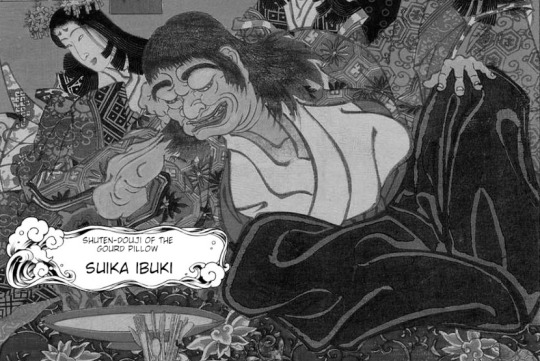
By popular demand, I wrote an article covering the background of Shuten Dōji and his underlings, and how it influenced Suika’s character and the idea of the Four Devas of the Mountain in Touhou. It was initially scheduled for last month, but I’ve experienced unplanned delays.
Read on to learn if you want to learn what Suika has to do with Yamata no Orochi and Mara, if it’s true that oni never lie, and more. I will also explain why making your own fourth Deva of the Mountain is entirely fair game and anyone telling you otherwise is wrong about the source material which inspired ZUN.
The article contains some spoilers for WaHH and a number of other Touhou installments, so proceed with caution if that might be an issue for you.
Ōeyama, or Shuten Dōji: origins
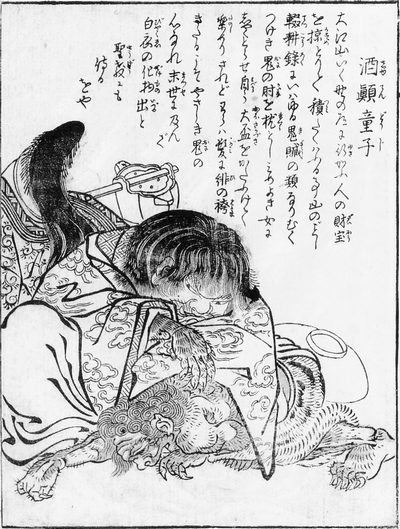
Shuten Dōji, as depicted by Sekien Toriyama in Konjaku Gazu Zoku Hyakki (wikimedia commons)
It perhaps seems a bit silly to start this article with an inquiry into the identity of Shuten Dōji (酒呑童子, “wine-loving youth” or something along these lines). After all, while Touhou characters are often based on obscure figures, Suika is hardly an example of that category. Shuten Dōji is arguably THE archetypal oni, known even to people with limited familiarity with Japanese mythology and folklore. And yet, the matter is nowhere near as clear cut as it might seem at first glance. From a certain point of view, Shuten Dōji might not even exactly be an oni, strictly speaking.
A book from Nara simply titled Ōeyama ("Mt. Ōe") offers a detailed account of Shuten Dōji’s origin. His father was not a man or a demon, but rather a mountain god, Ibuki Daimyōjin (伊吹大明神). That’s not all, though - according to a local belief, Ibuki Daimyōjin was actually Yamata no Orochi. How does that even work? Contrary to the more widespread tradition, the inhabitants of the area around Mt. Ibuki from the Muromachi period onward believed that Orochi survived his confrontation with Susanoo and hid in the mountains.
That’s actually not even the most unusual variant tradition about Orochi. A widespread belief through the middle ages was that he eventually managed to redeem himself, becoming a divine dragon (shinryū, 神龍) residing in the dragon palace under the sea. In that capacity, he was sometimes associated with emperor Antoku, with the latter even claimed to be his reincarnation, for example in a local legend associated with the Atsuta Shrine, preserved in the noh play Kusanagi. In esoteric Buddhist doctrine Orochi was sometimes perceived as a local manifestation (suijaku) of the buddha Yakushi - much like Susanoo was.
Ichijō Kaneyoshi in his Nihon shoki sanso (1455–1457) went into yet another direction, presenting the snake as identical with the naga girl from the Lotus Sutra. Apparently, he specifically means the version of her from Shaku Nihongi… who is identified there as Susanoo’s wife, down to being equated with Kushinadahime (this was not unusual in itself - Susanoo was equated with Gozu Tennō based on similar character, so it was sensible for their wives to be seen as analogous). This effectively created a scenario where Susanoo married his nemesis.

A Japanese depiction of the naga girl offering a jewel to the Buddha, as described in the Lotus Sutra (wikimedia commons)
Anyway, back to Shuten Dōji. According to Ōeyama, Ibuki Daimyōjin, before he even came to be known under this name, fell in love with the daughter of a local feudal lord, Sugawa. He started visiting her at night and she as a result eventually became pregnant. The identity of the visitor was unknown to her father, and out of frustration and fear that nefarious supernatural forces might be involved he eventually contacted various religious officials to perform exorcisms. Needless to say, Ibuki Daimyōjin was less than thrilled, and decided to display his divine wrath through rather conventional means: Sugawa was struck by illness. He once again summoned various Buddhist monks and onmyoji, this time to attempt to heal him. They concluded that the disease will disappear if the deity who caused it is properly honored, and established formal worship of Ibuki Daimyōjin, which apparently did indeed help.
Sugawa’s daughter eventually gave birth to Ibuki Daimyōjin’s child. The child started to cause problems at the age of three: his love of alcohol manifested for the first time, earning him the moniker of Shuten Dōji. By the time he was ten, his misdeeds were too much for his family to bear with and his grandfather decided to send him to Mt. Hiei to become a novice (chigo). The monastic lifestyle didn’t really change much though, and Shuten Dōji continued to drink. Eventually he managed to convince three thousand monks (sic) to drink with him and to join him in an “oni dance” during which everyone put on masks representing demons. The festivities lasted seven days. When Shuten Dōji woke up afterwards, he realized his mask had fused with his face, and he was no longer able to take it off. The other participants fled out of fear of his new form.
Shuten Dōji’s Mt. Hiei career was subsequently cut short by Saichō, the founder of the Tendai school of Buddhism. After learning what happened, he prayed to the buddha Yakushi and to Mt. Hiei’s protective deity Sannō Gongen to banish Shuten Dōji. It's worth pointing out that presenting young Shuten Dōji and Saichō as contemporaries is basically standard, and pops up in multiple legends. There are variants where Kūkai, the founder of Shingon, plays a similar role instead, to. They actually lived some 200 years before the other historical figures who appear in Shuten Dōji narratives, but this is not an oversight. It is a given that a partially divine being would live for much longer than a human.
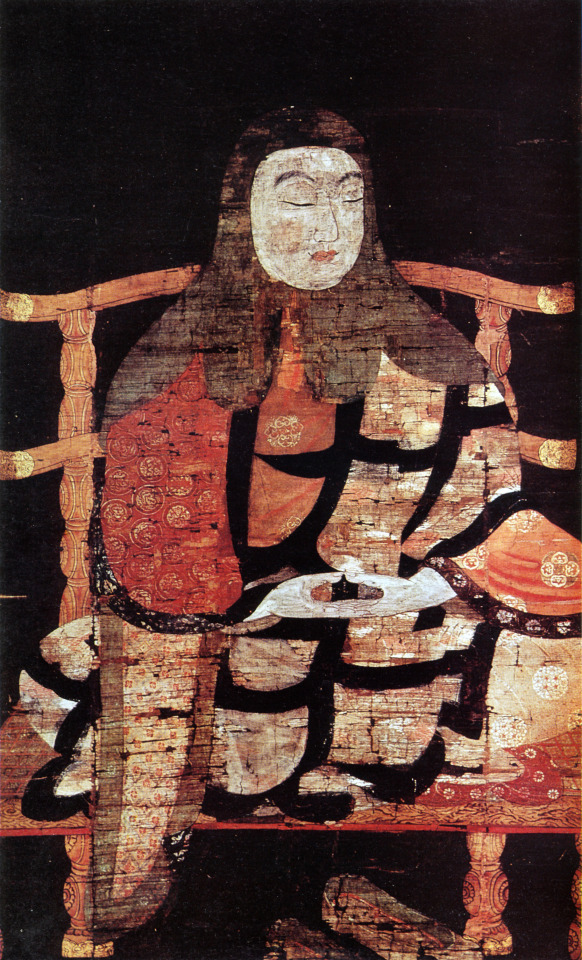
A Heian period portrait of Saichō (wikimedia commons)
As a result of Saichō’s success, Shuten Dōji had to flee. He tried to return to his grandfather’s residence, but this was no longer an option for him. He temporarily hid on Mt. Ibuki, but eventually left for Mt. Ōe, where he finally became a veritable "demon king".
The reason why Shuten Dōji was rejected by his family is that he was recognized as an “oni child” (鬼子, onigo). In the folkloric sense, this term refers to supernatural beings which are nonetheless partially human by birth. Not necessarily part oni, though. Another well known onigo, Sakata no Kintoki, was the son of a yamauba, for instance.
However, Yanagita Kunio noted that this term also referred to children born with teeth (a real, though very uncommon phenomenon), who were believed to turn into oni - much like how Shuten Dōji did. He states that especially before the Edo period this lead to cases of child abuse or outright murder. In some cases sending the child to become a member of Buddhist clergy was seen as a remedy. For example, a twelfth century monk named Jōjin in a letter relays that he suggested this to the mother of such a newborn. It is not hard to see that Ōeyama likely consciously references this custom.
The other origin of Shuten Dōji
Yet another tradition is preserved in a variant of the standard Shuten Dōji tale which switches the location of his demise from Mt. Ōe to Mt. Ibuki: here Shuten Dōji is not just any demon, but a manifestation of Mara. As in, the opponent of the Buddha and demon king of the sixth heaven, not some other accidentally similarly named figure.
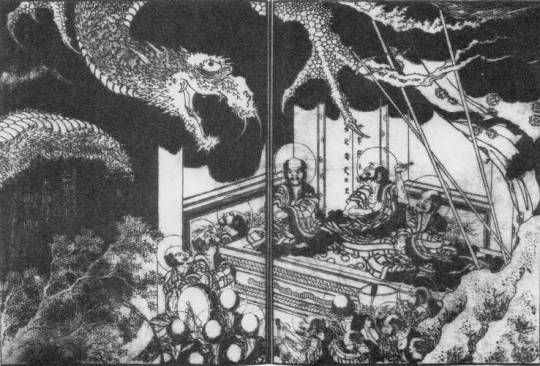
Mara, as depicted by Hokusai in Shaka-goichidai-zue (wikimedia commons)
It is presumed that this portrayal of Shuten Dōji might be tied to medieval Japanese traditions pertaining to Mara. They might sound unusual today: he was both a “demon king” (魔王) obstructing enlightenment, as expected, but also a jinushi (地主), or “landholder deity”. From the Buddhist point of view, jinushi were ambivalent figures: on one hand, their presence was responsible for bestowing specific locations with holiness. On the other hand, they could resist Buddhism as demonic forces, and had to be subjugated or converted to prevent that. Mara was the ultimate jinushi, the king of the world as a whole. A role already attributed to him in earlier Buddhist sources was basically adjusted for this framework.
The jinushi version of Mara originated among proponents of the imperial court and mainstream Buddhist institutions, but it curiously also gained traction among the opponents of these structures. Mara became somewhat of an anti-establishment icon more than once, essentially. A legend links him with (in)famous rebel Taira no Masakado (who you may know from SMT) for this reason.
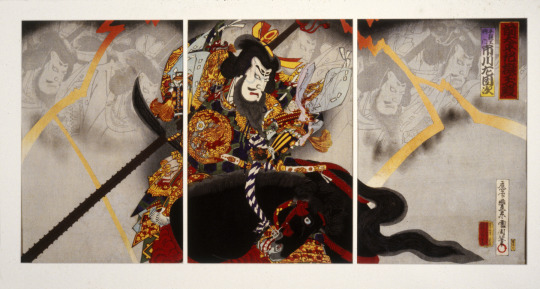
Masakado, as depicted by Kunichika Toyohara in Sen Taiheiki Gigokuden (wikimedia commons)
Other similar examples are also known. A local legendary figure from the Tsugaru peninsula in modern Aomori prefecture, Tsugaru Andō (津軽安藤), who after a failed rebellion fled to Hokkaido, was proudly described as a vassal of Mara by local officials who claimed descent from him. Prince Sutoku, a banished opponent of emperor Go-Shirakawa, swore a vow to become like Mara. Oda Nobunaga famously referring to himself as the “demon king of the sixth heaven” in a letter to Takeda Shingen is likely another example.
Reportedly a related belief that praying to the jinushi version of Mara can spare one from conscription persisted as late as the early 20th century, though generally he belongs to the realm of “medieval myths” which faded with the ascent of a new system of values in the Meiji period, in which the early imperial chronicles were favored. Even though it is largely forgotten today outside of specialized scholarship, there is much more to this Mara tradition. It led to the development of one of my favorite Japanese myths with no popcultural reception, but you will have no wait a few more weeks to learn more.
It has been argued that behind the identification of Shuten Dōji and Mara might reflect a historical event of the sort which led to associating the latter with figures such as Masakado. In other words, that Shuten Dōji in this case might be less a demon and more a demonized form of some opponent of imperial or religious authorities.
It has been argued that the Ibuki version was the result of combining an original oral narrative, a precursor of the textual versions we are familiar with today, with the memory of the death of a certain Kashiwabara Yasaburō, a bandit leader, in 1201. It has in fact been argued that even the mt. Ōe version might simply be a particularly fabulous reinterpretation of a punitive mission against bandits robbing and murdering travelers. Such rationalist explanations are not exactly new - Ekken Kaibara already argued in the Edo period that the legend of Shuten Dōji must have been the reflection of the downfall of a real bandit who perhaps wore the mask of an oni while committing robberies.
It’s important to bear in mind to not go overboard with this speculation, though. Ultimately the Mt. Ibuki version has a more pronounced religious character than other variants in general: Shuten Dōji’s nemesis Raikō’s is identified as a manifestation Bishamonten or Daiitoku Myōō (in the latter case, Bishamonten and the three other heavenly kings correspond to his four retainers), emperor Ichijō with Miroku (Maitreya), and Abe no Seimei, who plays a minor role in vanquishing the demon, with Kannon.
These equations reflect the idea of honji, or “true nature” of Buddhist figures, who were believed to take various guises through history to help people reach nirvana, for example these of local deities or historical figures. The best known example of application of this doctrine in Japanese Buddhism is obviously the historical phenomenon of honji suijaku, which was focused specifically on kami.
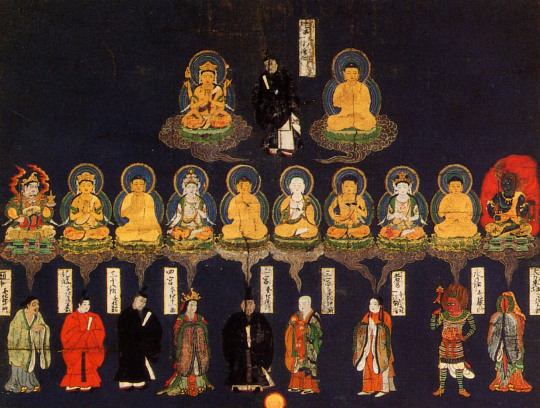
A Kasuga mandala representing the correspondences between Buddhist figures and local kami (source; reproduced here for educational purposes only)
The legend of Shuten Dōji
Regardless of which mountain is identified as the residence of oni, and of whether the dramatis personae are identified with Buddhist figures or not, the plot of the various versions of the legend of Shuten Dōji surprisingly does not vary all that much. While it is reasonably well known, I figured it won’t hurt to summarize it here anyway, especially since the information above should make it possible to view it from many new angles.
The oldest surviving version, Ōeyama Ekotoba (“Illustrations and Writing of Mt. Ōe”), presumably based on preexisting oral sources, comes from the fourteenth century, specifically from the Nanbokuchō period. However, the story only reached the peak of its popularity a few centuries later, in the Edo period. This was a part of a broader phenomenon: preexisting tales about warriors matched the sensibilities of the new ruling classes and were kept in circulation by them, but eventually they also became a part of urban popular culture. Many adaptations were produced, including noh plays and ukiyo-e. To put it very colloquially, the heroic warriors and demon quellers from the previous periods became the Edo period counterpart of contemporary superhero media. This is a genuine comparison employed in scholars, for clarity, not a joke.
As remarked by Bernard Faure, the most widespread version is basically framed as if it was a tabloid story from the Heian period. In 995, young women (and in some versions men too) disappear whenever a particularly violent storm occurs, and nobody knows how to stop it. Not even the power of Buddhist exorcisms is enough. Seeing as in the portrayed time period that was pretty much the universal solution to supernatural problems, this is a big deal.

Abe no Seimei (right) in the Fudo Rieki Engi (wikimedia commons)
This is a source of distress for a certain official, Ikeda Kunikata (or, in some version, Kunitaka), whose only daughter is among the kidnapped women. He decides to seek the help of the Heian period superstar Abe no Seimei, arguably the most famous onmyoji in history. Alternatively, the expert contacted is a certain Muraoka no Masatoki, who to my best knowledge is a fictional character and doesn’t appear anywhere outside of some variants of this tale.
Either way, thanks to this intervention it is possible to identify the culprit as a demonic being residing on Mt. Ōe (or alternatively on Mt. Ibuki). In one of the versions featuring Seimei he specifically identifies him as a tenma (天魔), “heavenly demon” - a term commonly used to refer to tengu (as ZUN does in Touhou) and to servants of Mara (overlapping if not identical categories, really; stay tuned for a future article exploring this).
However, onmyoji arts are not enough to stop the crisis; all Seimei can guarantee is that Kunikata’s daughter will survive, but he has no way to confront the demon directly. Kunikata therefore decides to bring the case to the attention of the emperor, Ichijō. He holds a meeting with various ministers, who note that in the past a similar case was solved by Kūkai (recall his already mentioned association with Shuten Dōji). However, there are no monks of equal skill left, so his feat cannot be repeated.
It is then concluded that the only way to end the demon’s reign of terror it is to send the strongest warrior they were aware of, Minamoto no Yorimitsu (Raikō) and his four retainers, Watanabe no Tsuna, Sakata no Kintoki, Taira no Suetake, and Tairi no Sadamitsu, on a mission to kill him. Raikō is also assisted by Fujiwara no Yasumasa (Hōshō) and his anonymous attendant, but these two never gained much prominence as characters in this narrative. Additionally, in some versions other figures from the same period - Taira no Muneyori, Minamoto no Yorinobu (Raikō’s younger brother) and Taira no Korehira - are namedropped as potential candidates considered by the emperor, but they all reportedly decline to partake out of fear.

Raikō and Kintoki, as depicted by Yoshitoshi Tsukioka (wikimedia commons)
Preparations started with prayers in Sumiyoshi, Kumano, Kasuga and, in some versions, Hie shrines. They did not go unanswered. Raikō and his retainers subsequently encounter a group of shugenja (mountain ascetics) who turn out to be the manifestations of the deities they paid honor to: Sumiyoshi Myōjin, Kumano Nachi Gongen, Hachiman (here addressed as a bodhisattva) and, if the Hie shrine is included in a given version, Sannō Gongen. They explained that to safely enter the fortress of Shuten Dōji, Raikō and his men must disguise themselves as shugenja (that’s because the legendary first shugenja, En no Gyōja, famously had an entourage of demons). They also provide him with supernatural wine. They state the oni will inevitably drink it due to their fondness of alcohol, only to end up poisoned as a result. In some versions they vanish afterwards, but in others they continue to accompany Raikō.
The protagonists then encounter a woman washing blood stained clothes. In some versions she is described as elderly, and states she has lived for 200 years as a servant of Shuten Dōji. In the most widespread Edo period version, she is young and says she was only kidnapped a year earlier, though.
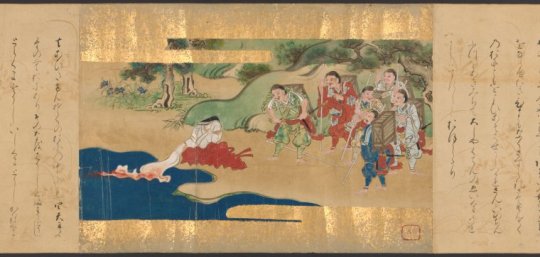
Encounter with the woman washing bloody clothes (NYPL Digital Collections)
Regardless of her age, she reveals some additional information about Shuten Dōji, though that also varies depending on the version. In some, she explains that he looks like a human during the day, but takes the form of an oni at night. His human form is specifically that of a dōji, literally “child”, but we’ll get back to the full context of this term later. In any case, I think it's safe to say the shape and size changing is where Suika'a ability came from.
In another variant, the woman warns the heroes that Shuten Dōji is enraged by Abe no Seimei’s actions, as the onymoji apparently figured out in the meanwhile how to keep the people of Kyoto safe by employing a number of shikigami (a standard part of his repertoire).
There are no further stops on the journey, and shortly after the encounter with the woman of variable age Raikō and his men enter the mountainous land of the oni. Especially in the older versions, it’s a place completely out of this world, with all four seasons occurring at once. Once they enter the fortress located there, they instantly encounter Shuten Dōji… and ask him for a place to stay for the night.

Distinctly human-like Shuten Dōji, as depicted by Yoshitoshi Tsukioka in One Hundred Ghost Stories from China and Japan (LACMA; reproduced here for educational purposes only)
Rather unexpectedly, he instantly agrees. He then tells them about his past; this largely a shorter version of the legend already discussed earlier, though with nothing predating the Mt. Hiei section mentioned. We also get a specific date for his arrival on Mt. Ōe, 849. This doesn’t last long, though, and soon he invites the protagonists to partake in a feast with him. This is obviously not a regular party, and while the individual versions can be more or less graphic, it is clear that the oni are consuing the flesh and blood of their captives.
Despite various horrific sights, Raikō maintains composure. He uses the opportunity the feast presents him with to offer Shuten Dōji the sake he received from the three (or four) deities earlier. As expected, Shuten Dōji gets drunk, and leaves to rest in his chamber.
The other oni continue to party. In some versions, some of them try to approach the protagonists by disguising themselves either as a group of courtly ladies or as a dengaku troupe, but Raikō’s glare is so intense they quickly relent. Eventually all of the oni give up on attempting to engage with the alleged ascetics and end up drunk.
That’s when the heroes decide to free their captives. These obviously include the women from Kyoto. However, as it turns out, Shuten Dōji’s rampages actually extended beyond Japan, to India and China, though only captives from the latter area actually appear. Multiple versions additionally mention that one of the prisoners was a young acolyte of the Tendai abbot Ryōgen, who was protected by assorted deities. This doesn’t really come into play in any meaningful way, though. Once everyone is freed, the heroes draw their weapons and enter Shuten Dōji’s chamber.
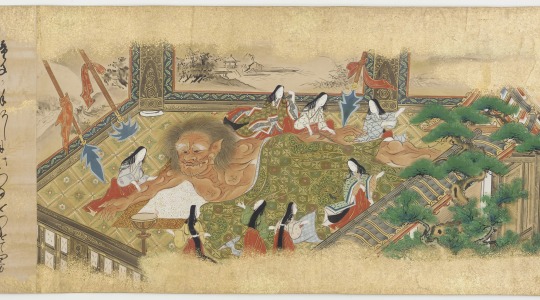
Sleeping Shuten Dōji (National Museum of Asian Art; reproduced here for educational purposes only)
The protagonists finally witness Shuten Dōji's oni form. He is five jō (around fifteen meters) tall, has fifteen eyes and five horns. His head and torso are red, his right arm is yellow, his left arm is blue, his right leg is white and his left leg is black. This might be a reference to the five elements. Alternatively, he could be described as entirely red, which might either be yet another way to reference his love of alcohol, as in the case of the shōjō, or an indication he was comparable to a “plague deity” (疫神, ekijin).
The manifestations of the deities from earlier show up again, this time to hold Shuten Dōji in place so that Raikō can strike. He cuts off his head, but to his shock it rises into the air and starts talking.

Confrontation between the heroes and the floating head of , as depicted by Yoshitsuya Utagawa (wikimedia commons)
Shuten Dōji actually mocks the heroes: “How sad, you priests! You said you do not lie. There is nothing false in the words of demons.” Needless to say, his final words are pretty directly referenced in Touhou. Oni, at the very least, claim they do not lie. Mileage of course varies, though.
ZUN is not the only author drawn to this element of the legend. It would appear that even the Japan Oni Cultural Museum has advertised itself with the words “there is nothing false in the words of demons” in the past. As noted by Noriko T. Reider, emphasizing this apparent honesty (or naivete) sometimes serves as a way to make oni sympathetic or even relatable for modern audiences.
However, it's worth noting that in the noh version, Raikō pushes back against Shuten Dōji’s words, and points out even the claim oni do not lie is a lie. He has a point, considering some versions outright establish oni capture their victims by disguising themselves as people close to them, imitating their voices. It probably also should be pointed out that in Konjaku Monogatari, oni are said to be scary precisely because they can tell apart right and wrong.
Anyway, oni ethics aside, it turns out that to kill Shuten Dōji for good, one has to gouge out his eyes. Once that is accomplished, Raikō's mission is finally complete. After killing the other oni, the protagonists take the head with them to Kyoto. Obviously, they also take the freed captives with them. The young women return to their families, and the Chinese men head for the coast to find a ship which could take them home. They promise to let the emperor (the Chinese one, for clarity; that would be Zhenzong of Song in 995) about Raikō's heroism.
In the versions where the woman washing clothes was elderly, rather than simply one of the young captives, on the way back the protagonists learn that she has passed away in the meanwhile, since her lifespan was unnaturally extended by Shuten Dōji. Once he died, so did she.
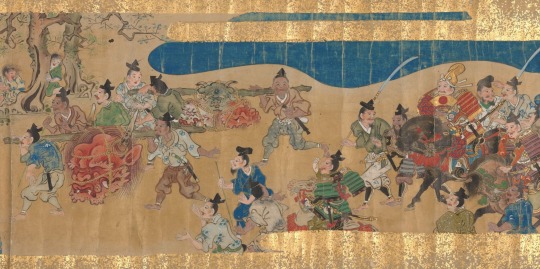
Transport of Shuten Dōji's head to Kyoto (NYPL Digital Collections)
Before the head can enter the capital, a purification ritual has been performed. Abe no Seimei thankfully knows how to do that. Thanks to him, all the relevant authorities can examine it. The emperor decides it will be best to store it in the treasure house of Uji. This location pops up in multiple legends. The severed heads of the two other equally famous malign entities, Ōtakemaru and Tamamo no Mae, were also stored there according to legends focused on them, in addition to various Buddhist relics and mundane treasures.
In an alternate version, the head never reaches the imperial court. Raikō and his retainers encounter the bodhisattva Jizou, who tells them it is too impure to be shown to the emperor, and suggests burying it. The location selected, a hill on the northwestern limits of the city, came to be known as Kubizuka (首塚), literally “head tumulus”. Shuten Dōji actually came to be enshrined there as Kubizuka Daimyōjin (首塚大明神), and in this divine guise developed an association with learning and ailments of the head.

The Kubizuka shrine in 2019 (wikimedia commons)
There is yet another variant tradition about the final fate of Shuten Dōji: after his death he became a vengeful spirit, and then turned into a tsuchigumo, just to be defeated by Raikō and his retainer Tsuna for a second time.

Raikō and Tsuna battling tsuchigumo, as depicted in Tsuchigumo no Sōshi Emaki (wikimedia commons)
Interestingly, it has been argued the tale of Shuten Dōji was at least in part based on that of the tsuchigumo Kugamimi no Mikasa (陸耳御笠), who resided on Mt. Ōe according to Tango Fudoki Zanketsu (丹後風土記残欠). The tale is not preserved fully, though, so all we know for sure other than the location is that the hero opposing him was Hikoimasu no Miko (日子坐王), a stepbrother of emperor Sujin (he is also attested in other sources). A second tsuchigumo, Hikime (匹女) is successfully defeated, but the fate of Mikasa is left unspecified in the surviving sections. This obviously makes further comparisons difficult. The topic of tsuchigumo cannot be dealt with here due to space constraints, but I promise I will return to it in a future article.
The supporting cast of Shuten Dōji
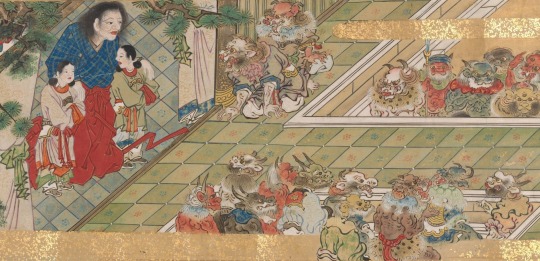
Shuten Dōji in his human form and his oni henchmen (NYPL Digital Collections)
Something that requires further discussion is the matter of the underlings of Shuten Dōji, since it is a topic directly relevant to Touhou. You might have noticed I actually avoided referencing them in any meaningful capacity in the summary of the legend. That’s because they actually do not play a major role. There also wasn’t any consistent view regarding their number or names. However, the version which came to be standard in the Edo period lists four of them - an obvious mirror of Raikō and his entourage. As a matter of fact, both groups even share the same moniker, Four Heavenly Kings.
This idea predates the Edo period, though. An earlier variant based on picture scrolls created by Kanō Motonobu already lists four servants of Shuten Dōji: Gogō, Kiriō, Ahō, and Rasetsu (yes, an oni named Rakshasa). However, two additional oni at his service are also listed, Kanakuma Dōji and Ishikuma Dōji. They are described as his personal guards, and as, well, dōji. It is clear the term is used in a literal sense here - they are said to look like “overgrown adolescents”. Two different subordinates are mentioned in another picture scroll: Kirinmugoku (麒麟無極) and Jakengokudai (邪見極大). However, they do not receive any characterization, or even physically appear in the narrative. Shuten Dōji shouts their names when he is about to die, and the very assumption that he’s referring to his oni subordinates is conjectural. The same version states that there were at least ten oni in the fortress so it’s not like it’s an implausible assumption.
The group of four oni returns in the standard Edo period version, where their names are Hoshikuma (“Star-bear”) Dōji, Kuma (“Bear”) Dōji, Torakuma (“Tiger-bear”) Dōji and Kane (“Iron”) Dōji. There’s also a fifth oni who is not a member of the group of 4, but shares the same naming pattern, Ishikuma Dōji. He actually gets a handful of lines, though they do not really provide him with much of a character beyond establishing he likes sake, that he eats humans, and that he is loyal to Shuten Dōji. Kane Dōji also gets a single line… explicitly alongside Ishikuma and multiple other nameless oni, though, and it boils down to announcing they will go down fighting because without their leader they no longer have a place to go.
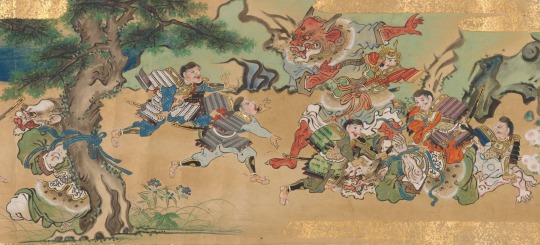
Defeat of the oni (NYPL Digital Collections)
Ibaraki Dōji: Shuten Dōji’s only equal?
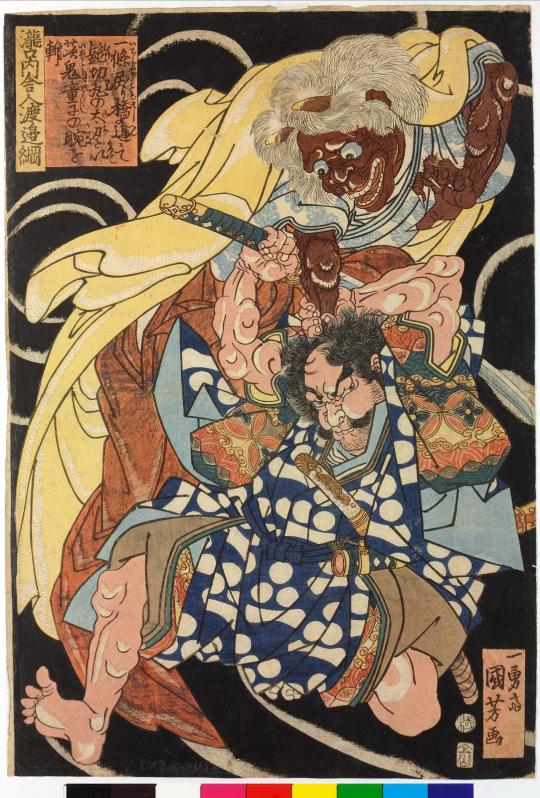
Watanabe no Tsuna battling Ibaraki Dōji (wikimedia commons)
A further unique case is that of Ibaraki Dōji, who actually acquired some fame as an individual character, and today is sometimes cited as an example of an oni equally archetypal as Shuten Dōji.
Despite being portrayed as a close associate of Shuten Dōji, Ibaraki Dōji to my best knowledge isn’t counted among the Four Heavenly Kings in any version. The character of the connection is evidently more nebulous. I know an assertion that a tradition presenting Ibaraki Dōji as Shuten Dōji’s wife is attested is repeated as fact on wikipedia and various at least semi-credible websites, but there is never a citation provided, and no version of the narrative covered in articles and monographs I have access to includes such an element. I am not claiming it is impossible, though I do feel the fact it doesn’t come up in any paper or monograph discussing either figure I have access to doesn’t mention to might indicate it’s either a recent reinterpretation or a very obscure local variant. Note this is not meant to be an argument against any Touhou ships.
What I can say with certainty is that Ibaraki Dōji’s gender is actually a matter of occasional academic dispute. In the versions of the basic Shuten Dōji narrative which mention this oni, he is pretty firmly male. However, he is said to be capable of taking the form of a woman. Noriko T. Reider argues that on this basis it can be effectively assumed that at the very least this specific oni can be considered genderless or capable of freely changing their gender, though she tentatively extrapolates this ability to oni in general.
While Ibaraki Dōji’s gender changing adventure is technically its own legend, a reference to it was incorporated into the basic Edo period version of the Shuten Dōji narrative. During the feast, the latter mentions in passing that the former, his trusted ally, lost his arm in a fight with Watanabe no Tsuna during one of their Kyoto raids, after failing to abduct him while disguised as a woman. He clarifies that the arm was later recovered, but not particularly many details are provided.
The rivalry between Tsuna and Ibaraki Dōji subsequently comes into play after Shuten Dōji’s death, when the protagonists are about to exterminate the other oni. Ibaraki charges him and they two fight without a clear winner for a while, until Raikō intervenes and kills the oni. I would argue that despite him being responsible for dealing the killing blow, it is Tsuna who should be considered Ibaraki’s nemesis, though. Interestingly, at some point ZUN considered featuring a character based on him in Wild and Horned Hermit (source). That obviously did not come to pass, though.
Tsuna already fights an oni in Heike Tsuruginomaki, and many other variants of the story were written subsequently, with the noh play Rashōmon being the most famous. Curiously, the oldest version makes no reference to Shuten Dōji, and the oni actually resides on Mt. Atago, but by the Edo period the two were regarded as allies operating from Mt. Ōe.
The details are otherwise generally similar across all of the sources. Raikō sends Tsuna on an errand. He encounters a woman on the Modoribashi Bridge in Kyoto, but as soon as he offers to take her with him she turns into an oni. Thinking quickly, he cuts off the creature’s arm, which is enough to make them flee. He keeps the severed limb as a trophy. Some time later, he is visited by an old woman who he assumes is his aunt... but who turns out to be the same oni, who uses a brief moment of confusion to recover the arm and fly away.
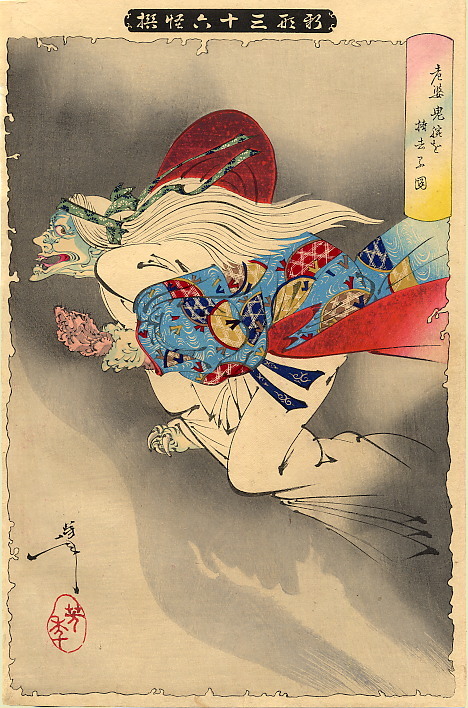
Transformed Ibaraki Dōji, as depicted by Tsukioka Yoshitoshi (wikimedia commons)
The legend of Ibaraki Dōji was evidently reasonably popular in the Edo period, and could even be utilized to comedic ends. One example is an Edo period satirical pamphlet, Thousand Arms of Goddess, Julienned: The Secret Recipe of Our Handmade Soup Stock, written by Shiba Zenkō and illustrated by Kitao Masanobu. Here the one-armed Ibaraki Dōji is one of the figures interested in leasing one of the now detached additional arms of the Thousand-Armed Kannon, who has apparently fallen in dire straits (“business slumps are inevitable, even for a Buddha”, comments the narrator, alluding to the financial conditions of the 1780s). As we learn, after making a purchase Ibaraki is disappointed by the lack of hair, and promptly hires a craftsman to add it:

Original translation by Adam L. Kern; reproduced here for educational purposes only. I am not responsible for the typesetting.
In my recent Ten Desires article I’ve already discussed the oni of Rashomon as a character in legends about Yoshika no Miyako, which I won’t repeat here. It will suffice to say that this conflation effectively made Ibaraki a penchant for poetry and fine arts, and that it indirectly put him in the proximity of the pursuit of immortality. Whether this is why ZUN made Ibaraki’s counterpart a wannabe immortal (“hermit”) is difficult to ascertain, but it does not strike me as impossible.
The oni of Rashomon actually appears in at least one more legend which similarly portrays him as an enthusiast of the arts, though to my best knowledge this one never came to be reassigned to Ibaraki Dōji. It is centered on a famous biwa player, Minamoto no Hiromasa, who has to resolve the case of mysterious theft of an instrument from the imperial palace. As you can expect, it is revealed to specifically be an exceptional biwa, which bears the name Genjō. Hiromasa surveys the city in hopes of finding it, and eventually hears its distinct tones while passing near the Rashomon gate. He quickly realizes an oni is playing it. He politely asks if he can have it back, since it’s a treasure of the imperial court… and the oni eagerly obeys, thus bringing the story to a happy end. However, we are told Genjō acquired supernatural qualities in the aftermath of the theft, and only played when it felt like it, as if it was a living being.
There is a variant which reveals that the oni of Rashomon was in fact the ghost of Genjō’s original maker, a craftsman from India. In this version, Abe no Seimei has to intervene to recover it, and the oni only agrees to return it after being promised a night with a woman he fell in love with who resembles his deceased wife. There is no happy ending here, though, as the woman’s brother convinces her she needs to kill the oni. She fails, and meets such a fate herself instead. It seems that the reader’s sympathy is actually supposed to be with the oni in this case.
Conclusions, or why you should make your own Deva of the Mountain

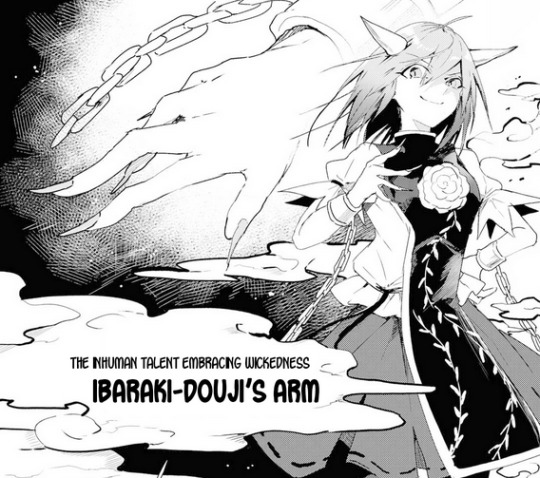
Obviously, there is nothing novel or clever about stating that the two figures this article is focused on, Shuten Dōji and Ibaraki Dōji, correspond to Suika and Kasen respectively. You can learn that from the official media itself, after all. Funnily enough, it seems this might have been even more blunt, judging from unused ideas for referencing the legend to an even greater degree in WaHH, with the defeat at Mt. Ōe as the explanation why oni reside… well, elsewhere (source). Granted, it would also be a disservice to ZUN to say he only created anime girl versions of the classic oni. He effectively created his own versions of both Shuten and Ibaraki - for every similarity between the irl background I’ve described and Touhou, there is also something brand new. That is part of what makes Touhou compelling, I would argue.
Naturally, the fact that the group Kasen and Suika belong to is referred to as the Four Devas of the Mountain shows clear inspiration from the Edo period version of the original legends. However, Suika and Kasen are counted among the four, which is obviously an innovation. Additionally, while Yuugi is naturally named after Hoshikuma Dōji, who you were able to meet earlier, save for the name she is effectively a fully original character. Her ability references the Analects of Confucius, rather than anything directly tied to Shuten Dōji. And, on top of that in all honesty, she has more character than any of the additional oni appearing in the real legends. ZUN, as far as I am concerned, created a more than worthy addition to the classics.
What about the much discussed fourth deva? I think it’s safe to say that in the light of the discussed material there simply isn’t a single most plausible option. As I stressed already, there’s no consistent group of oni appearing alongside Shuten Dōji, and it cannot be said that the Edo period version is clearly what should be treated as true in Touhou. ZUN picked what he liked from many versions.
For what it’s worth, so far all of the oni forming the Four Devas are based on those who share the moniker of dōji, so that’s the closest we have to a theme. As I already said earlier, this term can be simply translated as “child” (or “lad”, though I think a gender neutral option is more apt since we are talking about Touhou here, ultimately). However, it has a more specific meaning when applied to supernatural beings. In this context it refers to a category of ambiguous figures characterized by “vitality, (...) hubris, and (...) unpredictability”, as well as fondness of violence, as summarized by Bernard Faure. Shuten Dōji, and by extension his underlings, are obviously the dōji par excellence. However, the term could also be applied to benevolent, or outright divine beings. That, however, goes beyond the scope of this article.
I personally think despite the possible dōji theme the fourth slot will never be filled, ultimately. ZUN likes leaving gaps in established groups - there are types of tengu which were a part of the background for well over a decade, for instance. I think these are left as paths to make ocs with an instant excuse to interact with canon characters. Despite ZUN’s generally pro-fanwork stance I do not think I’ve ever seen anyone make this point.
As far as I am concerned, the conclusion is clear: it’s entirely fair game to invent characters to fill the empty spot. There’s even a solid case to be made for reinventing oni from other legends as members of the Four Devas - remember that much of Ibaraki Dōji’s character was borrowed from a nameless oni from a legend about the Rashomon gate, as I discussed last month.
Bibliography
Bernard Faure, Rage and Ravage (Gods of Medieval Japan vol. 3)
Michael Daniel Foster, The Book of Yokai. Mysterious Creatures of Japanese Folklore
Adam L. Kern, Thousand Arms of Goddess, Julienned: The Secret Recipe of Our Handmade Soup Stock, written by Shiba Zenkō and illustrated by Kitao Masanobu (translation and commentary), in: An Edo Anthology: Literature from Japan’s Mega-City, 1750–1850
Keller Kimbrough and Haruo Shirane (eds.), Monsters, Animals, and Other Worlds. A Collection of Short Medieval Japanese Tales
Irene H. Lin, The Ideology of Imagination: The Tale of Shuten Dōji as a Kenmon Discourse
Michelle Osterfeld Li, Human of the Heart: Pitiful Oni in Medieval Japan in: The Ashgate Research Companion to Monsters and the Monstrous
Noriko T. Reider, Shuten Dōji: "Drunken Demon"
Idem, Japanese Demon Lore
Idem, Seven Demon Stories from Medieval Japan
also check out the scans of an amazing Shuten Dōji picture scroll from the NYPL collection here!
156 notes
·
View notes
Text
Inazuma Lore: A Series Part 2/?
Part 1 was about historic setting, part 2 will be very long, about one of my favorite characters and her beautiful lore.
As we all know, Kokomi is the Head-Priestess of Sangonomiya Shrine and, I haven’t actually seen anyone saying this but, the people of Watatsumi Island are supposed descendants of the people from the Enkanomiya following Orobashi’s purpose of creating human-like serpent, so she should be descendant of Orobashi and the serpent creatures/vishaps.
“ The ancient people of Enkanomiya co-worshipped Orobashi, the coral serpent, with Ouroboros, the scaleless imaginary serpent. Its influence led to the end of the worship of the Dainichi Mikoshi and many of the corrupt practices established by the Sunchildren regime. Orobashi brought with its newfound rule drastic changes to Enkanomiya society, including changing from the ancient Watatsumi language to the Narukami-style language. Following a certain prophecy, it prepared the people of Enkanomiya to return to the surface world and had them become acclimated with Narukami and Inazuman conventions.“ [source]
Enkanomiya’s story is way more elaborated but I’ll focus exclusively on Orobashi first.
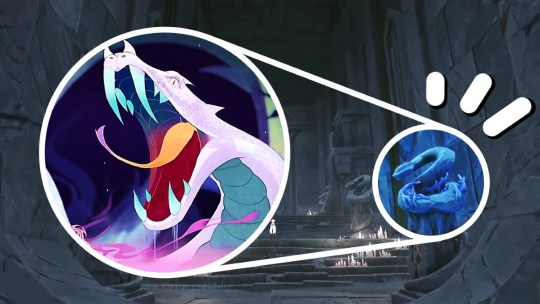
He is a serpent, he gets addressed as Orobashi no Mikoto (オロバシノミコト), like Gods are usually addressed, and his name comes from the word “orochi”, which means serpent.
In Japanese Mythology different type of serpents exist, one of them is called Yamata no Orochi (ヤマタノオロチ, also 八岐大蛇), or simply Orochi (大蛇), who’s a eight-headed and eight-tailed Japanese dragon/serpent. (besides the ancient orochi reading, 大蛇 is read daija, "big snake; large serpent").
Japanese Myths can be founded in two books, Kojiki and Nihon Shoki, the first two ancient books in Japanese language, which tell the stories of the Japanese Gods and creation of Japan.
In both versions of the Orochi myth, the Shinto storm god Susanoo, God of Thunder, is expelled from Heaven for tricking his sister Amaterasu, the sun goddess. After the expulsion from Heaven, Susanoo encounters two "Earthly Deities" weeping because they were forced to give Orochi one of their daughters every year for seven years. When time came for Orochi to get the eight daughter, Susanoo helped them by getting Orochi drunk, intoxicated by the drinking all his heads lay down and slept and Susanoo killed him with his sword.

The parallel in-game for this myth would be Raiden Shogun killing Orobashi, just like Susanoo kills Orochi, during the Archon War, creating the Musoujin Gorge on Yashiori Island, and Serpent’s Head being Orobashi remains.
In the Myth, Susanoo makes Orochi intoxicated with a rice wine (sake) called Yashiori no Sake (八塩折之酒/八醞酒 "eight-fold refined liquor").

This being said, Orobashi can be linked to another dragon/serpent God because of his purpose of creating a human-like serpent creature and dream of living above surface.
Ryūjin (龍神), which in some traditions is equivalent to Ōwatatsumi (大海神 “great sea god”), was the tutelary deity of the sea in Japanese mythology. In many versions Ryūjin had the ability to transform into a human shape. Many believed the god had knowledge on medicine and many considered him as the bringer of rain and thunder.
Ryūjin lived in his palace under the sea built out of red and white coral, pearls, crystal, and sea creatures like jellyfish, turtles, fishes are his servants.
There’s several Shrines dedicated to this particular god in Japan, the model for the Sangonomiya Shrine (珊瑚宮 "Coral Palace") whose Kokomi is Head-Priestess, is located in Okinawa, Shuri Castle.

The Ryūgū-jō (竜宮城 "Dragon palace castle") in myths, is also palace of princess Otohime (乙姫), second daughter of the Dragon King (Ryū-ō). [see folktale of Urashima Tarō for the story]
In conclusion, all of this is what brings me to believe Kokomi is a descedant in human form, of Orobashi.
1 / ?
#kokomi#sangonomiya kokomi#genshin sangonomiya#sangonomiya shrine#kokomi sangonomiya#watatsumi island#watatsumi shrine#genshin impact#genshin lore#inazuma lore#genshin inazuma#i hope this didn't feel like an info dump#and that it's clear enough#i love all of this sm#kokomi princess of the sea#and of the enkanomiya#im so bad with words forgive me
7 notes
·
View notes
Text
Glass Bottle Packaging Market Insights: Comprehensive Global Forecast (2023-2032)
The global market for glass bottle packaging is expected to grow from its estimated USD 26154.2 million in 2023 to USD 37225.58 million in 2032 at a compound annual growth rate (CAGR) of 4.00% between 2024 and 2032.
Glass Bottle Packaging Market encompasses the production and distribution of glass bottles used for packaging a wide range of products across various industries such as beverages, food, pharmaceuticals, and cosmetics. Glass is a preferred packaging material due to its ability to preserve product integrity, maintain purity, and enhance shelf life without interacting with the contents. This market is driven by the demand for sustainable and recyclable packaging solutions, as glass can be recycled multiple times without loss of quality or purity.
Additionally, the aesthetic appeal of glass bottles makes them popular for premium and artisanal products. Challenges in this market include competition from alternative packaging materials such as plastics and metals, which are often lighter and less fragile. However, increasing environmental concerns and consumer preference for sustainable products are expected to continue to drive growth in the glass bottle packaging market. Innovations in glass production, such as lightweighting techniques and enhanced durability, are also pivotal in maintaining the competitiveness of glass bottles in the packaging industry.
The transparency of glass also allows consumers to view the product inside, enhancing its visual appeal and helping in quality assurance. Moreover, glass is highly recyclable, supporting eco-friendly packaging initiatives as it can be reused and recycled indefinitely without losing purity or quality. Despite facing competition from plastics and other materials due to issues like weight and fragility, glass bottles remain popular in markets that value product purity and sustainability. Innovations such as lighter and more break-resistant glass are helping to address these challenges, keeping glass bottles a relevant choice in the packaging industry.
Major Key Players-
Gerresheimer (Germany)
Vitro Packaging (U.S.)
Verallia (France)
BORMIOLI ROCCO SPA (Italy)
KOA GLASS CO., LTD (Japan)
BA Glass B.V. (Spain)
Amcor plc (Australia)
Ardagh Group S.A. (Luxembourg)
Nihon Yamamura Glass Co. Ltd. (Japan)
Vetropack Group (Switzerland)
Heinz-Glass GmbH & Co. KGaA (Germany)
Glass Bottle Packaging Market Key Findings of Study-
Sustainability as a Major Driver: Studies consistently find that sustainability is a crucial driver for the glass bottle packaging market. Glass's ability to be recycled indefinitely without loss of quality makes it highly attractive in the context of global environmental concerns and the push towards circular economies. This is increasingly important as consumers and regulatory bodies demand more eco-friendly packaging solutions.
Increased Demand in Specific Sectors: There is a notable increase in demand for glass bottle packaging within certain sectors such as alcoholic beverages, particularly premium spirits and wines, as well as in the pharmaceutical industry where product integrity and safety are paramount. These industries value glass for its non-reactive properties, which ensure product purity.
Innovation in Glass Production and Design: Technological advancements in glass production are critical to addressing some of the inherent disadvantages of glass, such as its weight and fragility. Innovations such as lightweighting techniques, which reduce the weight of glass bottles without compromising their strength, are significant. Additionally, aesthetic enhancements and custom designs are increasingly being used as a marketing tool to differentiate products on shelves.
Challenges of Cost and Logistics: Despite its advantages, the higher cost of production, coupled with logistical challenges associated with its weight and fragility, remains a significant hurdle for the glass bottle packaging market. Studies find that these factors can limit the use of glass packaging in industries where cost-efficiency is more critical than aesthetic appeal or chemical inertness.
Impact of Consumer Preferences: Consumer preference for glass over other materials due to perceived quality and safety, especially in food and beverage products, supports the market growth. However, there is also a growing competition from high-quality plastics and other alternative materials that are improving in terms of safety, quality, and environmental impact.
Regulatory Impact: Regulatory trends towards reducing plastic waste have a positive impact on the glass bottle market. Legislation in many countries that encourages recycling and sustainability practices can lead to increased use of glass packaging.
Market Opportunities in Emerging Economies: The expansion of the market in emerging economies is driven by increasing consumer spending power, urbanization, and the growth of industries like beverages and pharmaceuticals. Local production initiatives are also starting to take shape, driven by the need to reduce costs and carbon footprint.
More About Report- https://www.credenceresearch.com/report/glass-bottle-packaging-market
Glass Bottle Packaging Market Dynamics-
Drivers
Sustainability Trends: The increasing focus on sustainability is a significant driver for the glass bottle packaging market. Glass is highly recyclable and can be reused multiple times without degradation in quality, making it attractive in a global push towards sustainable practices.
Consumer Perception: Consumers often perceive glass packaging as higher quality compared to plastics or metal. This perception is particularly strong in industries like beverages (especially wine and spirits), premium cosmetics, and gourmet food products where the packaging can significantly influence purchasing decisions.
Product Integrity and Safety: Glass is chemically inert and does not leach chemicals into its contents, which is crucial for maintaining the purity and safety of packaged products, especially in the food and pharmaceutical sectors.
Challenges
Cost and Fragility: Glass packaging is generally more expensive and heavier than other packaging materials like plastic and aluminum. Its fragility also increases the risk of breakage during transport and handling, potentially increasing logistics costs and product loss.
Competition from Alternative Materials: Plastics, metals, and composite materials are often favored in applications where weight and durability are more critical. Innovations in these materials, such as improved recyclability and barrier properties, further intensify the competition.
Energy Consumption: The production of glass bottles typically requires more energy and resources compared to other packaging materials, primarily due to the high temperatures needed to melt and mold the glass. This can also add to the environmental footprint unless mitigated by using recycled glass.
Trends
Lightweighting: To combat the issue of high transportation costs and to improve their environmental footprint, glass manufacturers are focusing on lightweighting their bottles without compromising on durability and integrity.
Premiumization: In sectors like alcohol and perfumery, there is a trend towards premiumization where brands use distinctively designed glass bottles as a part of their marketing strategy to attract high-end consumers.
Technological Advancements: Advances in glass production technology help in creating more durable and less breakable glass packaging. For instance, chemical tempering and thermal treatments are being used to enhance the strength of glass bottles.
Localized Production: To reduce transportation costs and carbon footprint, there is a trend towards localizing the production of glass bottles closer to the customer base or filling locations.
Segmentation:
By Type of Glass
Clear Glass Bottles
Amber Glass Bottles
Green Glass Bottles
Blue Glass Bottles
Other Colored Glass Bottles
By Shape and Design
Standard Round Bottles
Square or Rectangular Bottles
Oval Bottles
Specialty-Shaped Bottles (e.g., flask-shaped, vintage-style)
Customized Designs
By Closure Type
Crown Caps
Corks
Screw Caps
Swing Tops
ROPP (Roll-On Pilfer Proof) Caps
Others
Browse the full report – https://www.credenceresearch.com/report/glass-bottle-packaging-market
Browse Our Blog: https://www.linkedin.com/pulse/glass-bottle-packaging-market-projections-pkrzf
Contact Us:
Phone: +91 6232 49 3207
Email: [email protected]
Website: https://www.credenceresearch.com

0 notes
Text
Sakagura and JETRO Presents The Art of Japanese Liquor
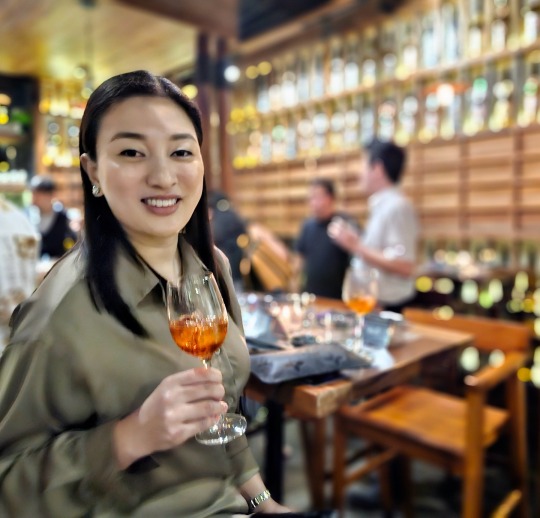
The Japan External Trade Organization (JETRO) recently hosted an exquisite Japanese wine and sake pairing dinner called The Art of Japanese Liquor at Sakagura in Bonifacio Global City. Together with industry partners Philippine Wine Merchants, Hightower, and Mitsukoshi Fresh, JETRO introduced its VIP guests to some of the finest sake and shochu cocktails in the country, paired with the freshest seafood and wagyu dishes from Sakagura.

The exclusive dinner event happened last February 1, 2024 at the new Sakagura izakaya and sake bar located on the second floor of One Bonifacio High Street Mall in Bonifacio Global City. The Hungry Kat was one of the few selected guests invited to this one of a kind sake pairing to promote the unique Japanese liquors available in the country.

Indulge in the art of Japanese cuisine at Sakagura, which opened its doors to the public only late last year. This new premium sake bar is from The Nikkei Group which also owns and operates popular brands like Nikkei Nama Bar, Sunae Asian Kitchen, and Terraza Martinez, among others. Sakagura offers a selection of premium sakes from renowned Japanese breweries which you won't often find in other Japanese restaurants.
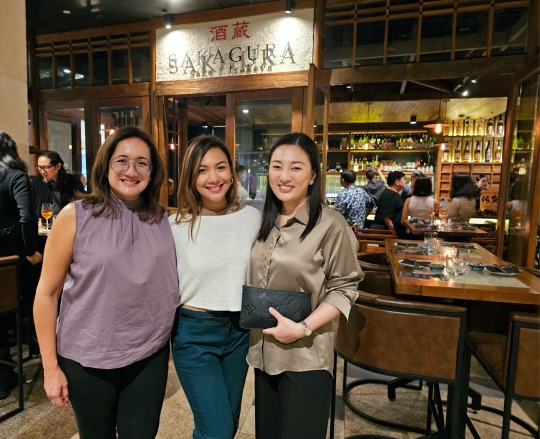
It was just our first time to visit Sakagura so I was happy to find some familiar faces including the evening's host Gail Sotelo and Nikkei Group marketing manager Monica Modomo.
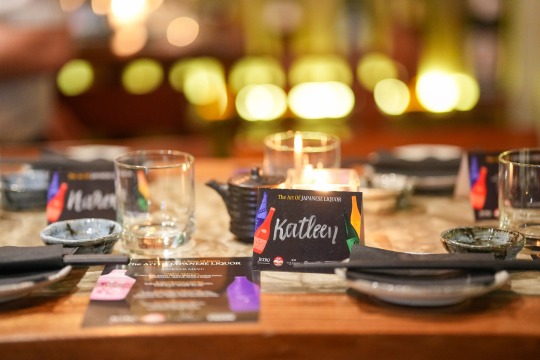
Guests were ushered to their seats where a medley of premium Japanese cocktails will be introduced and served throughout the evening, all paired with lovely dishes from Sakagura.


The Art of Japanese Liquor actually started even before we got to sit down. Guests got a small taste of what was to come with their Welcome Drink, the Aperol Spritz blended with sparkling sake.
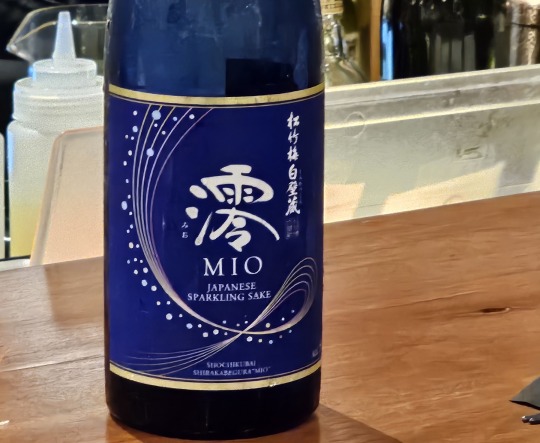
I love drinking Aperol Spritz which is an Italian cocktail, but Sakagura gives it a unique Japanese twist by using sake instead of Prosecco.

We also got to chat with The Nikkei Group owner Carlo Lorenzana together with JETRO Manila Director Makoto Sudo who works with retailers and restaurant owners to connect them with the best Japanese wine suppliers available.
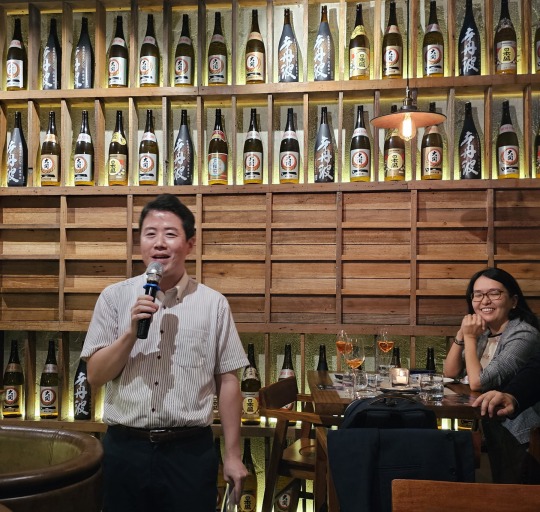
Mr. Sudo-san, as he is fondly called, welcomed all the guests to The Art of Japanese Liquor and gave a brief introduction to Japanese wine including the differences between sake and shochu.
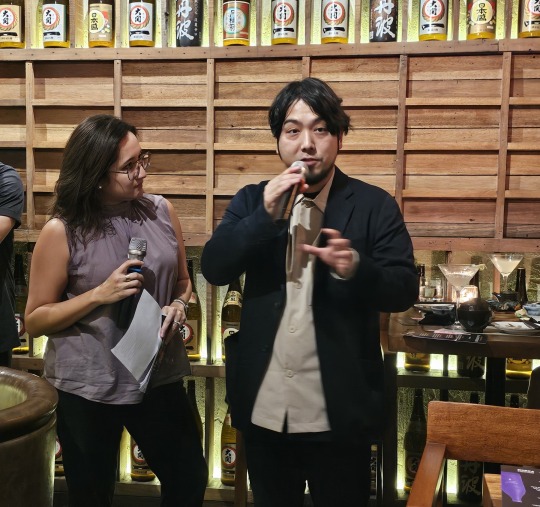
All these premium Japanese liquors are available at Mitsukoshi Fresh BGC, one of our favorites supermarkets where we can always find amazing Japanese products at very reasonable prices. JETRO has worked with Mitsukoshi Fresh to bring these authentic Japanese liquor to the Philippines


Our table was very excited to explore these colorful Japanese cocktails. Joining us were Ms. Heidi Ng, a journalist who also happens to be a classmate of my husband back in Ateneo; Ms. Jackie Lorenzana, owner of The Nikkei Group; and Attorney Karen Jimeno who we have seen countless times on the news for her cases and advocacies.

We started our adventure with the Nihon Sidecar which is made with Daiyame Sweet Potato Shochu, lemon juice, cointreau, aperol, and brown sugar. This is a sweet and refreshing cocktail that can be enjoyed any time of the day.

Our delightful beverages were paired with a sample of the best bar chows you can find courtesy of Sakagura Executive Chef Yonemoto Kazumasa. Chef Yonemoto crafted the evening's dinner from the day's freshest catch.

I heard that Sakagura flies in their seafood straight from Japan every week, so we knew we were getting the best quality items as if we were eating in Tokyo. The Sakagura Sashimi (P1,680) is a platter featuring the Chef's Choice of the day's best sashimi cuts like Toro Tuna, Salmon and Hamachi sashimi.

We can really tell by the color and tenderness of the sashimi that these are really fresh. We got to explore some of the restaurants in Tokyo and Osaka last year and I have to admit that dining at Sakagura is as close as you can get to actually being there in Japan.
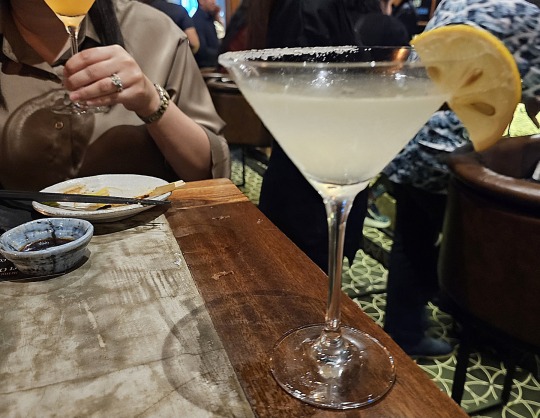
There were several other cocktails to try on the menu. The Yuzu Margarita is also made with Daiyame Sweet Potato Shochu together with Arette Blanco tequilla, lime juice and simple syrup. This is a more powerful combination for those that want a stronger cocktail.
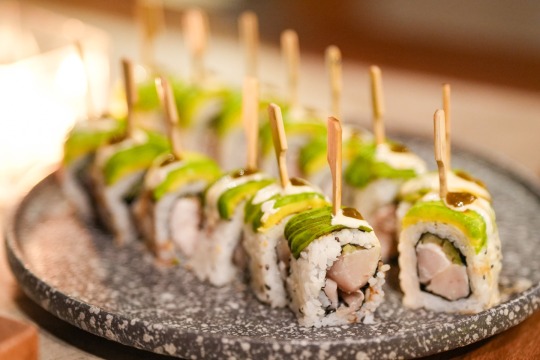
We had this with the Hamachi Tataki, a harmonious mix of tender hamachi, refreshing cucumber, and smooth avocado, finished with a tangy yuzu mayo and kosho.
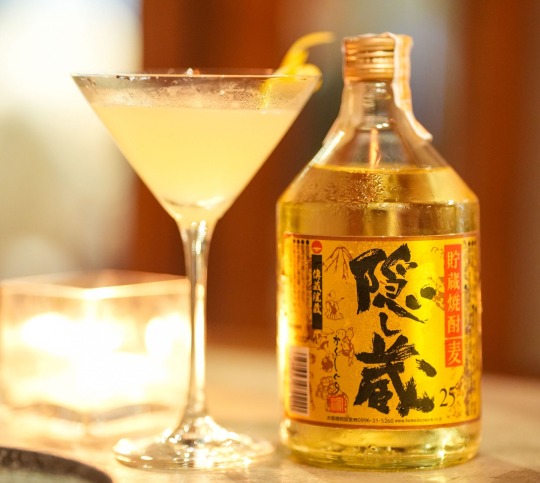
Next up was the Sakagura Martini which brings together Kakushigura Barrel Barley Shochu with Masamune "Malola" Junmai Ginjo Sake, Tanqueray Gin, and Takara Mio Sparking Sake. Now this is a combination that really gives a strong kick.

The Assorted Sakagura Handrolls (P2,250) is one of the restaurant's unique specialties. This is a culinary mosaic made of the finest ingredients. The handrolls are each made with kani, uni, hamachi, salmon and tuna, all prepared with their own ingredients. The Salmon handroll is the perfect blend of tender trout, creamy avocado, and rich cream cheese rolled to perfection. On the other hand, the Uni Ikura handroll comes with Hokkaido's sea urchin, ikura, and Nikkei sauce.
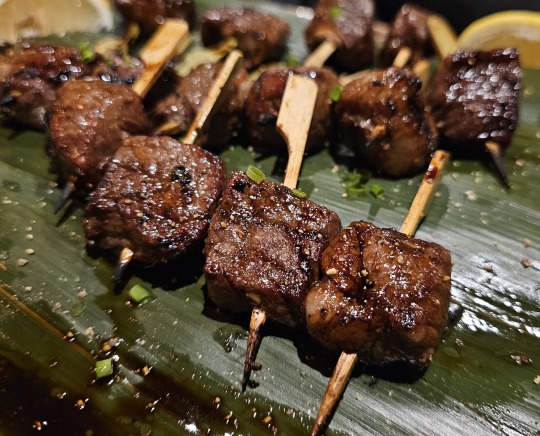
To make the evening even more special, the Japanese Wagyu Skewers (P980) was a savory complement to all of the Japanese cocktails. These tender wagyu cubes were grilled perfectly, with each bite bursting with flavors.

The last drink I tried was the Kagoshima Gimlet which combines Kakushigura Barrel Barley Shochu with lime juice and simple syrup. After having a taste of all four cocktails, I think my personal favorite would be the Sakagura Martini for its rich and strong mix of spirits.

It seems that they were saving the best for last as Sakagura brought out the highlight of the evening, their signature Miso Bone Marrow (P750).
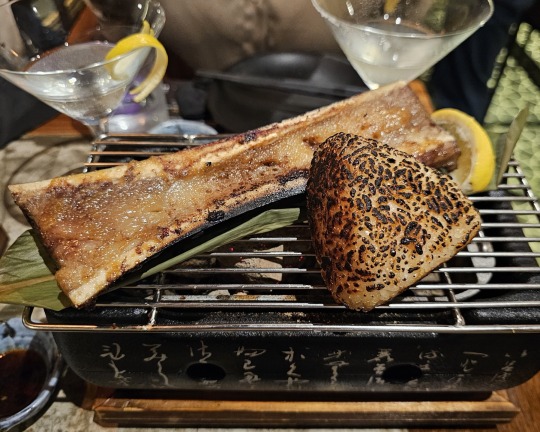
This beautiful slab of glistening bone marrow is served on its own individual griller and perfectly paired with uni butter onigiri. This is a dish that speaks volumes of the intricacy of Japanese cuisine. You can eat both items separately, but better yet, slather some bone marrow on top of the hot onigiri for a more indulgent experience.

For dessert, we had out choice of Hokkaido Mille Crepe Cakes (P380) in both matcha and chocolate flavors. This was topped off with some ice cream for a fantastic finish.

We would like to thank Sunny Ku of Mastermind Asia Communications Inc. for inviting us to join this special evening filled with delicious Japanese food and drinks. We really love Japanese cuisine so we absolutely enjoyed The Art of Japanese Liquor. Thank you to JETRO and The Nikkei Group for hosting this fabulous event.

Sakagura
2/F One Bonifacio Mall, 28th Street, Bonifacio Global City, Taguig
(0956) 029-4791
www.nikkei.com.ph/sakagura
www.facebook.com/sakaguramanila
0 notes
Video
undefined
tumblr
勝沼ぶどう郷 2021年秋
“Genuine” Japanese Wine in Koshu-City Japan in autumn 2021
Katunuma Japan, November 2021
We can look at the enlarged images clicking the original ones.
The term for "genuine" Japanese Wine (Nihon-Wine) is defined by Japanese Wine Labelling Rule. Japan Wine (Nihon-Wine) only refers to the wine which is made from ingredients 100% made in Japan. (Visit Japanese Winery)
0 notes
Video
youtube
Please watch this video and learn Japanese word! Today's Japanese word is 酒 (SAKE alcohol in Japanese) (* ̄0 ̄*)ノ☆ https://youtu.be/pWlRmlDc_CY
#Japanese#Japan#nihongo#nihon#nihonshu#osake#sake#learn japanese#learn japanese online#kakehashi#kakehashijapan#kakehashi japan#study japanese#whisky#wine#japanese wine#alcohol#yopparai#futsukayoi#nomika#izakaya#jlpt#n5#n4#n3#n2#n1#puni puni#puni puni japan
9 notes
·
View notes
Video
strange sake labels by kazu saito
Via Flickr:
タクシードライバーなんてお酒があるんだ!?
11 notes
·
View notes
Note
"Why is it so damn difficult for you to believe you're worthy of love?" but it's Kurogane saying it to Fai because we all know who the one that needs therapy is in that duo lol
They are given the luxury of time in Clow following the battle. A few days to rest and recover, to look back on what has transpired and consider what should be done moving forward. Syaoran spends almost every moment with Sakura, as is to be expected. Kurogane finds his time filled with Fai at his side; each morning, a knock at his door marks the start of a new day as the mage comes to fetch him. They take their meals together, wander the town and the castle together, visit the medics for checks and fresh bandages together. At the end of each night, they share some of Clow’s sweet wine and then part ways for their own beds.
Mokona usually hops between the two pairs depending on how she’s feeling that day, but she usually sleeps curled against Sakura’s neck.
They spend this evening on the balcony of Kurogane’s room. Kurogane’s weight is leaning against the thick stone safety railing and Fai is sat precariously atop said railing. Kurogane would have barked at him to get down, but he knew that Fai would easily be able to save himself if he happened to fall.
“Syaoran is going to have to leave soon,” Fai murmurs, eyes watching a lone, drifting cloud. “Time is ticking.”
“Hn.” Kurogane grunts in response as he takes a drink. “And what’re you gonna do?”
“I was thinking I’d join Syaoran-kun, if he’ll take me,” Fai responded. “It would break my heart if he had to do this on his own. And it’s not like I have anywhere else to go!”
Fai laughs as if the depressing statement is a joke. He’s tense, Kurogane notices, the topic of conversation painting a plastic smile on his face. Kurogane wants to tell him to knock it off. The sight of it makes something crawl under his skin.
“And Kuro-sama?” Fai asks, his gaze turning to the ninja. “You’ll return to Nihon, right? Tomoyo-chan must be thrilled you’re finally returning.”
Kurogane clears his throat before responding, “No, actually. I contacted her last night. I’m gonna join the kid, too.”
Fai’s rehearsed smile falls for a brief moment as he’s struck with surprise instead. His eyes shine impressively even under the dark sky until he shuts them with a laugh. “I would have thought Kuro-sama would run home as soon as he could, but Syaoran-kun will be so happy!”
Kurogane doesn’t ask the question lingering on his tongue—and Fai? How does he feel about it?
Kurogane clears his throat again—there’s nothing stuck in it but it’s tight for some reason as he continues on the topic. “It’s not like it’ll last forever. I’ll go back to Nihon when we get those two idiots back and I can give them a proper punishment for worrying us.” Fai’s smile softens as Kurogane speaks, the first vestiges of something real as he chuckles quietly to himself. Kurogane continues, “And… y’know if you wanna settle down somewhere when it’s all over… you can always come back to Nihon with me.”
“...Eh?” The surprised look is back on the mage’s face, his smile frozen from the pure shock of the question. He laughs nervously for a moment and looks away from Kurogane as he processes the question. “To Nihon? D-Did Tomoyo-chan say she has a job for me?”
Kurogane’s brows furrow with a frown. “No. I mean, I dunno. There might be a job you can do, but it’s not like you’d need one. Tomoyo and the Empress wouldn’t kick you out, anyway, and besides. I can work enough to cover you.”
“M-My, is there something in the wine?” Fai is laughing again, forced and awkward like he doesn’t know what else to do or say. “You’re making yourself sound like an old-fashioned father—I didn’t know Kuro-sama could make such jokes!”
“I’m not joking, you idiot,” Kurogane tells him, frustration rising hot in his blood at Fai’s adamant refusal to accept what Kurogane is telling him. “What’s so hard to believe about taking care of someone you love?”
There’s a pause, a moment when even the air around them seems to still along with Fai’s breath. “...Love?” It’s a quiet murmur, more to himself than anything, spoken like a child hearing an unknown word for the first time.
Kurogane’s frustration dissipates in an instant, his shoulders falling with a sigh. “Yes, you idiot. Love.” He should have known better than to assume Fai’s strongly built defenses would fall so quickly, even if the mage was trying. Kurogane has been honest with his feelings for such a long time now, he didn’t think there was a way Fai couldn’t see it. But if Fai, in his self-taught method of avoidance, refused to see it, there was no other choice than to say it outright.
Fai silently turned and pushed himself off the balcony railing to fall silently to his feet. He cradled his glass of wine close to his chest, like it could act as a shield somehow. “K-Kuro-sama shouldn’t tease me so much.”
The forced happy tone from before has disappeared. Now, he sounds properly hurt, his voice trembling as if on the edge of tears. He begins to leave and Kurogane catches him by the arm to stop him.
“Oi, what the hell have I done recently to make you think I’m lying?” He asks Fai. “You think chopping off my own arm was my way of teasing you?”
Fai’s eyes—two again, and Kurogane didn’t know how much he loved the color blue until that moment—widen as guilt sweeps over him. “I-I didn’t—” He lowers his head as if in shame. “I didn’t… mean it like that…”
Because of course Fai had to know, no matter how much his toxic thoughts tried to tell him otherwise, that Kurogane at least cared for him. No person would willingly give up their own blood and tie them together for life, nor cut through their own flesh and bone without another thought without at least some bit of concern and attachment. And Fai would always feel guilty for those decisions, even if Kurogane was adamant that they were his choice and he would make them again.
“After everything,” Kurogane releases Fai’s arm to tap his knuckle against the underside of Fai’s chin, gently getting him to lift his head. “Why is it still so damn difficult for you to believe you’re worthy of love?” Kurogane asks, voice so soft and mushy it surprises even himself. He can’t help it though, nor can he bring himself to care. Not now. Not with Fai.
Something teeters over the edge within Fai and his eyes immediately fill with tears. Although Kurogane never wants to see the way his lips tremble before parting with a much needed sob, he will always prefer the open honesty over the fake smile. Kurogane wraps his one arm around Fai and lets the mage have his much needed cry, slender fingers grasping desperately at the front of Kurogane’s shirt as tears stain the fabric.
“Come back to Nihon with me, mage,” Kurogane says, whispers into Fai’s hair like a secret kiss. “When it’s all over, come with me.”
Fai is rendered speechless for a long while, his throat tight and words interrupted with gasping, cathartic sobs that are sometimes mixed with unabashed, joyous laughter. He nods in immediate agreement. Kurogane only holds him closer.
113 notes
·
View notes
Text
to the walls i built around you
Fandom: Tsubasa: Reservoir Chronicles
Pairing: Kurogane/Fai
Rating: T
Word Count: 4.2k
Summary/Tags: Kurogane and Fai are having a good time on their first date when Fai wins a mysterious gemstone at the local summer solstice festival and everything goes wrong from there. Written for KuroFai Olympics 2021, Team Sun, Prompt: Groundhog Day. TW for anxiety on Fai’s part.
[Read on Ao3]
--
The sun sits low on the horizon, casting long shadows along the gently sloping landscape of the country they’d dropped into just yesterday. Fai leans against the railing of their temporary apartment’s balcony and watches as the dark slowly creeps over the city below, fire-light lanterns lighting gradually along the city streets. He takes a long sip of wine and focuses for a moment on twirling the glass stem between his fingers. The air around him is hot enough for it to be uncomfortable, even though he’s stripped down to his barest layer. It’s muggy as well - a sensation that he finds even more uncomfortable than heat itself, as he can feel the dampness in the air begin to cling to his skin.
Fai sets his wine glass on the railing and buries his head in his hands as he replays the night’s events over and over again in his mind.
“It looks like they’re holding a summer solstice festival.” Kurogane explained, settling their groceries down on the counter, “We had something similar in Nihon.”
Fai hummed in response and focused on putting things away, only half-listening to what Kurogane was saying.
“We should go.” Kurogane handed him another bag and Fai very pointedly didn’t look at him.
“Sounds fun. I’ll ask Syao--”
“ We should go.” Kurogane was behind him now, close enough that Fai could feel the warmth radiating from his body. Fai’s heart sped up as he set the last box in the cupboard and turned, slowly, to face Kurogane.
“The kid said he would be busy anyway. Something about researching local legends,” Kurogane continued, staying a small distance from him to give Fai his space. Fai looked up and they locked eyes for a long moment. His breath caught in his throat, his heart pounding hard in his chest. Even with all of the stilted confessions they’d laid bare to each other after the battle with Fei Wong Reed, Fai still felt unable to accept whatever this was - whatever it could possibly become.
No matter how many times Kurogane held him, no matter how many whispered endearments he’d been offered, it still didn’t feel quite real . He can’t quite stop himself from thinking of all of the possibilities - every tiny thing that could go wrong and snowball into something that would completely alter the way Kurogane might feel about him, and that stops him, even now, from reaching out and moving this forward.
“If you insist, Kuro-sama,” Fai gives him a small, mischievous smile, “but you’re paying.” Fai’s heart leapt into his throat as Kurogane grinned back at him, clearly pleased with himself.
“Tomorrow. It’s a date,” Kurogane said, turning on his heel and making his way out of the kitchen before Fai could say anything in response.
Fai slumps against the balcony railing and lets out a long sigh, trying not to let his nerves get the better of him. He feels a little silly, all things considered, worrying about going on a date after everything that had happened.
=-=
The sun begins to peek over the horizon, signalling the start of a new day, and Fai feels like he’s barely slept a wink. He’s always been an early riser and until this point, it hasn’t really bothered him. He finds himself awake long before the other two so much as stir in their beds and he spends this time pouring over the five outfits he’s managed to accumulate up to this point, trying desperately to figure out which combination of the five would suit a summer solstice festival, an event he knows next to nothing about, and a date.
Fai closes his eyes for a moment and mulls over the choices. His normal travel wear was out of the question and his original clothes seemed a bit out of place as well. Cracking his eyes open, he runs his fingertips over the soft chiffon blouse he’d picked up in Moryo country. High neckline, flowing lantern sleeves, detailed ruffling around the wrists, and muted glitter shimmering within the fabric - he remembers liking it so much that he’d refused to sell it when they’d arrived in the next world - but Kurogane was never one for frivolous details was he?
Fai sets it aside and moves on to the next set neatly folded beside it. A simple cotton shirt with thin golden embroidery lining the sleeves and small embroidered flowers decorating a thin breast pocket. Practical and thin, maybe a bit too casual for a date? It was hot enough that this would likely be the best option, as he glanced over at the last outfit and remembered it was more well-suited for winter months.
Fai shuts his eyes again and focuses on breathing for a moment before grabbing the cotton shirt and heading to the bathroom to get ready for the day.
=-=
Fai finds himself fussing over very menial tasks around the apartment until Kurogane is finally ready to leave for the festival. He’d flip-flopped all morning about so many tiny details that by the time Kurogane came to tell him it was time to leave, he was already exhausted and it was barely mid-day. At the last minute, Fai had changed his mind and decided upon the long-sleeved chiffon blouse - a decision that he is now regretting based both on how hot it is outside and also because he seems to be woefully overdressed.
The townsfolk around them are all dressed in casual summer clothes, similar to the types they had seen back in Hanshin country years ago. The crowds are thick in the market square with people crowding around the varieties of colorful booths lining the streets. There’s barely enough room to walk through and Kurogane sticks close enough to him that Fai starts to overheat embarrassingly fast . Kurogane seems absolutely unbothered by the heat, as per usual, a fact that Fai used to be envious of until they had managed to land themselves in a world with a tundra climate similar to his home country and Kurogane’s teeth hadn’t stopped chattering the entire time they’d been there. Fai glances up at Kurogane and smiles, fond memories of teasing Kurogane while they both shared his longcoat springing to the forefront of his mind.
Kurogane looks down at him and raises an eyebrow, but Fai just grins back at him in response. The crowd gets thicker and harder to navigate to the point where they nearly get seperated a few times, so when Kurogane offers his hand, Fai takes it. His palms are sweaty, both from the heat and his own nerves, but Kurogane says nothing and simply pulls him along until they reach their destination.
They stop at a few food booths and Kurogane orders for the both of them - most of the things on the menus look like nothing he’s ever seen before, and a majority of it is pretty good, apart from the one crispy food that Kurogane hands to him that turns out be some sort of battered fish. Fai begrudgingly swallows that one down and makes a mental note to sneak way too much sugar into Kurogane’s coffee tomorrow morning.
Eventually, they make their way to the small park at the center of the city square. There are more tents set up in the park, all lined with glittering lights and colorful tapestries. While a majority of the booths they’d seen up to this point were more focused on food, these tents seemed to be hosting a variety of games. Kurogane has stopped leading him since there are less people in this part of the square, and Fai pauses to let his eyes wander over the first few booths in the line. A game with a bunch of colorful bottles, one with tiny children’s bow and arrows, and one - one that he feels an odd sort of pull toward.
Fai wrinkles his nose, suddenly even more on-edge as he takes in the curved lines of a red, orange, and black wheel painted to look like a giant sun. He stares at it for a long moment, trying to figure out just what about it seemed odd. He’s so focused on it that he nearly jumps out of his skin when Kurogane places his hand on the small of his back, gently guiding him toward the booth.
“Let’s check it out, you seem curious enough about it.” Kurogane says, and Fai can feel his face heating up even more - if that was even possible (he probably looked like a giant tomato at this point, dear gods) .
As they get closer to the booth, Fai can see small pegs lining the outer ring of the wheel with tiny words written in between them. Up-close, the sun painted on the wheel looks distinctly familiar, but he can’t quite place where he’s seen it before. Kurogane hands the game tender an amount of money and Fai watches as he spins the wheel. It lands on a word that he can’t read and the attendant grins as he pulls a box out from behind the wheel.
“Ah, a wonderful prize from the box of mysteries, my friend! You never know what great treasures you may find!” The attendant gestures to the top of the box and that strange pull that had pulled him here grew just a bit stronger. When he sticks his hand in the box, he feels a few boxes, a few things that feel like rubber, and something - something that seems to fit itself into the palm of his hand all on it’s own. Fai is no stranger to magic and he can practically feel whatever this object is pulsing with unreleased energy.
He pulls it out and opens his palm to reveal a strange orange gem with streaks of red running through it. It feels odd in his hand - strangely right, and that makes him nervous. Magical objects that seek out their users are generally not good news.
He’s pulled out of his reverie by Kurogane tugging lightly on his sleeve, leading him away from the booth. Fai pockets the gem without much thought and follows him, tentatively brushing his hand against Kurogane’s and smiling when the ninja twines their fingers together as they walk further into the park.
The sun has fully set by the time they reach a little alcove with a small park bench that Kurogane had apparently been leading them to. Kurogane plops himself down on the bench and makes himself comfortable, raising an eyebrow at Fai when he doesn’t follow.
“What are we--” Fai begins, and Kurogane closes his eyes and leans back into the bench.
“Fireworks. Should be starting in about half an hour.”
Fai sits and almost immediately becomes very aware of how sweaty he is as he leans back on to the bench seat and feels the chiffon of his shirt stick to his skin as he shifts. They sit in silence for a few minutes - a fact that had Fai’s nerves building in the pit of his stomach, even if he can’t rationalize why he’s nervous. The night around them is loud with chirping crickets and the far-off sounds of the festival. Fai shifts again, wanting desperately to unbutton a few of the top buttons of his shirt but feeling much too awkward to do so.
Kurogane shifts next to him, placing one of his arms along the back of the bench behind Fai’s head and Fai feels like he needs to fill the silence with something, literally anything, so he says the first thing that pops into his head.
“Do you come here often?” Immediately as he says it he wants to drop his face into his hands and never look Kurogane in the eye again. Kurogane says nothing for a long moment and when Fai finally chances a look up at him, he’s grinning down at him.
“We’ve only been here for two days,” He says, clearly amused, “I happened by this place on the way back from the market yesterday.”
Fai puzzles over this for a moment and then comes to a realization, “Did you plan all of this?”
Kurogane looks up to the sky and hums in response.
“I have something for you.” Kurogane glances over at him and smiles, soft and easy, and Fai feels his heart nearly skip a beat as he pulls a small box from his pocket and places it on the bench between them.
Fai feels like his heart is literally going to pound out of his chest, a million different scenarios running through his mind as he picks up the tiny box, slowly unties the ribbon, and slides the top off. He stills as soon as he sees it, glittering on top of soft white cotton. A beautifully intricate hair comb made of weaving silver and deep blue gemstones. Fai stares at it for a long while and when he finally looks up, Kurogane is still smiling at him.
He takes the box from Fai’s hands and lifts the comb from it, turning it over in his hands.
Kurogane leans closer and Fai focuses on trying to keep his breathing steady as Kurogane brushes a few locks of stray hair behind his ear.
“Your hair is getting long. I thought you could use something to tie it back.” He says, brushing his thumb over Fai’s cheek. Fai closes his eyes as Kurogane guides him to turn around and gathers all of his hair into a bun. He’s surprisingly gentle - more gentle than Fai could ever imagine Kurogane being, and when it’s all said and done Fai feels much cooler now that his hair is off of his neck.
Fai chuckles as he turns back around, trying to will himself to calm. Absently, he sticks his hand in his pocket and when his fingers hit the gem he’d picked up earlier, he closes his hand around it. It’s surprisingly cool for having been in his pocket for a while now, which should be odd, but he doesn’t exactly have time to think about that as Kurogane leans forward once more and touches their foreheads together. He’s so close that Fai can’t really think straight, his heart once more pounding away in his chest, panicking, panicking as Kurogane closes the distance between them and --
=-=
Fai wakes just as the sun begins to peek over the horizon, signalling the start of a new day, and he feels like he’s barely slept a wink. His heart is still pounding like crazy as he sits up in his bed and tries to parse through what had just happened. Had he blacked out? Had Kurogane carried him all the way back to their apartment and put him to bed? He thinks hard for a moment, trying to remember anything that happened after Kurogane kissed him - tried to kiss him? He doesn’t actually remember it happening, now that he thinks about it.
Fai sighs and brings his knees up to his chest, resting his chin on the soft flannel of his sleep pants. The same pants he’d been wearing two nights ago. He feels something heavy and cold in his left palm and as he slowly uncurls his fingers, he recognizes the gem he’d picked up last night. It takes him a moment - longer than he would like to admit - to realize what’s going on.
Quickly, he makes his way out of his room and down to the kitchen. He checks the fridge and sure enough, the leftovers from two days ago that he’d eaten for breakfast yesterday were still sitting on the top shelf. Fai closes his eyes for a moment and gently shuts the fridge door, his fist tightening around the gemstone still in his hand.
Magical objects that seek out users are almost always bad news. He repeats to himself as he slowly climbs the stairs back up to his room. As he readies himself for the day, he finds himself to be much less nervous this time. He already knows how the night is going to play out and that gives him an advantage, right?
He wears the short-sleeve cotton shirt this time, knowing how hot it’s going to be, and he manages to get a few chores done while waiting for Kurogane to come downstairs. Very purposefully, he’d left the gemstone tucked away in one of the drawers of his nightstand.
Kurogane comes downstairs at the same exact time he had yesterday and greets him in the same way. He holds out his arm for Fai to take as they make their way to the market square. They get the same food but this time, Fai knows Kurogane is going to try and trick him into eating fish - so he purposefully orders something else for himself at that booth. It’s something that he doesn’t quite understand, but it sounds good when Kurogane describes it, even if he does give Fai an odd look after he’s ordered.
Fai pops exactly one of the tiny balls of dough into his mouth and immediately regrets all of his life choices up to that point. His eyes start watering, from the spices burning his tongue and all the way down his throat, and when he looks up Kurogane is clearly holding himself back from laughing at him. That tittering nervousness he’d managed to lock away is now back in full-force as he tries to run to the nearest water fountain, ends up tripping over something, and lands in a very conveniently placed mud puddle.
He’s wet, muddy, and his mouth is on fire, when he feels that odd pull he’d felt the night before, tugging at his hand and guiding it to his pocket. The gemstone sits within, even though Fai knows he’d locked it away in that drawer.
“You alright--” Kurogane only gets two words out before Fai closes his fingers around the gemstone.
=-=
He wakes once more at the first light of dawn.
The third time is much quicker - Fai manages to accidentally push Kurogane into a fountain and calls it quits right after that. The fourth time he somehow ends up free falling from the ferris wheel in the park and probably breaking his ankle - he doesn’t stick around to find out. Fifth, sixth, seventh, and eighth are all absolute disasters as well, and by the ninth time he sends himself back, he’s completely and utterly done.
Before anyone in the apartment even wakes up, Fai is storming down to the park, heading straight for the booth he remembers having the sun wheel game. It’s still early in the day and most of the vendors are setting up shop, but oddly enough in the spot where he definitely remembers the sun wheel booth being, there is an empty space. When he asks around at the other vendors, no one seems to remember a booth ever being there, despite this being the second day of the festival. He closes his eyes and counts to ten, trying to will the frustration down, because of course no one has heard of that booth.
Eventually he heads back to the apartment and shuts himself in his room, refusing to answer the door when both Kurogane and then Syaoran try to get him to come out. His plan at this point is to wait the day out to see what happens - getting out of a cursed time loop was more important than Kurogane being upset with him for missing a date.
Except, Kurogane is never one to sit idly by, particularly when he thinks Fai is doing something stupid, and he ends up getting Mokona to unlock his bedroom door because he’s worried.
Fai doesn’t say anything as Kurogane steps into the room, he just pulls the covers over his head and waits. Kurogane ends up sitting on the opposite side of his bed and Fai hears him let out a long sigh that has him instantly regretting his life decisions again.
“Mage,” Kurogane says, and when Fai doesn’t answer, “ Fai.”
The gem is set out in front of him, shimmering on it’s own underneath the blankets. Fai closes his eyes and brushes his fingers across the smooth stone.
“ If I’ve done something to make you -” is all Kurogane gets out before Fai closes his hand around the gem once more.
=-=
The fifteenth time, he figures it might be a smart idea to try and recreate the first night, because at this point, he’s barely even making it past leaving the apartment without panicking and restarting the day. He’s steadily grown more nervous over the days and he knows it’s not helping him but he can’t seem to stop.
As he gets ready that morning, he puts on that same too-hot blouse and tucks the gem away in his pants pocket. They manage to make it to the town square without anything super disastrous happening. Fai had stepped in a puddle and now one of his shoes was wet and squeaky, but all things considered, that was a minor inconvenience. He lets Kurogane lead him around the food booths and chokes down the same fried fish he’d eaten on the first night. He spills his drink on Kurogane and feels his fingers itch, that pull resurfacing and trying to pull his hand toward his pocket, but he ignores it.
When they make it to the park, the booth with the sun wheel is still not there - the space where it had been is empty and oddly placed. They end up playing a ring toss game instead and somehow , somehow, he manages to angle the ring in just the right way so it bounces back at them, hits Kurogane directly in the eye, and leaves him with a giant black bruise. What are the odds? Fai is just about to reach into his pocket when Kurogane starts laughing. Fai gets him an ice pack from the festival’s medical tent instead, and Kurogane teases him relentlessly about it until they find themselves at the same bench where they’d talked that first night.
Kurogane sits first, gestures for Fai to join him , and Fai does, resigned to the fact that the night was almost over and he’d not only managed to spill hot chocolate all over Kurogane, but also gave him a black eye. Fai slumps in his seat, takes in a long breath, and briefly contemplates whether he should just try one more time.
“You look upset.” He hears Kurogane say, and when he turns to look at him, he’s frowning.
Great, Fai thinks, you’ve managed to upset him again. At this point, he decides definitively that he is going to start over one more time. Maybe he just won’t eat anything the next time, maybe Fai can convince Kurogane that they should just avoid the festival altogether and do something entirely different.
Fai sighs and looks up at the sky. The stars are barely visible with all the lights from the festival so close by.
“I mean, it’s been a pretty awful day,” Fai says, very pointedly not looking in Kurogane’s direction.
He nervously fiddles with the opening to his pocket, one moment away from reaching in and closing his fingers around the gem once more, when Kurogane laughs. It starts out as a gentle chuckle and cascades into a full-blown fit of laughter that has Fai wondering just what about this situation is funny.
He’s about to ask when Kurogane finally calms himself and gives him a sidelong glance, effectively stopping him in his tracks. Kurogane is still smiling, a soft and gentle smile as he takes Fai’s hand in his own and interlaces their fingers.
“I don’t think this even counts as one of the top ten worst days we’ve had together, Mage.” Kurogane says, and Fai feels himself flush as Kurogane runs his thumb over Fai’s cheek, “It’s been eventful, sure, but when is it not? I had fun. Didn’t you?”
Fai simply stares at him for a long moment and realizes that in all of his worry and confusion, he’d completely forgotten exactly why he likes - no, loves Kurogane as much as he does. He slowly pulls his free hand out of the pocket with the gemstone inside and brushes his fingertips along Kurogane’s jaw until they meet the back of his neck and tangle themselves in his hair. In this moment, Fai cannot even begin to remember everything he’d been so worried about or why he’d even been worried about it in the first place, as Kurogane squeezes their hands together and leans forward to rest his forehead gently against his own.
It’s Fai that closes that final distance between them, a soft and hesitant kiss that turns into something more, something deeper, in mere moments. Kurogane pulls away first and when Fai finally comes out of the haze of finally kissing this man that he’d been pining over for literal years at this point, he notices Kurogane staring at his pocket, eyebrows furrowed in confusion.
“Your pocket was just glowing.”
Fai reaches into his pocket and pulls out a small shard of shattered stone. He smiles and tosses it to the side, pulling Kurogane in for another kiss.
=-=
When he wakes the next morning, just as the sun begins to rise over the horizon, he’s greeted with the sound of light snoring behind him and a heavy arm wrapped around his waist, and he feels free.
12 notes
·
View notes
Text
Apeiron/Uncreation locales
She called this place Uncreation because it was where angels went when all the cosmic realms had been destroyed. Cas suspected it before, but he knew for certain now. She had entirely missed the point. This place was a world of trial runs and test drives. It was a record of the past as much as a model of the future. It was a world of endless creation, running parallel to the still, small centre of humanity, Earth.
will this ruin the magic? let's hope not. there were a lot of things I drew from, some more specific than others. the deserts and galaxies I leave to your imagination, as to the rest...
In the sand he passed a giant foot carved of stone, as tall at the top as he was, and reaching higher only to leave off just above the ankle with a jagged break. Not far from it, half-sunk in the sand, a broken head. One empty eye watched him. He approached and placed his hand upon the bridge of the nose, out of which time had taken a deep cut.
“Ozymandias, King of Kings,” he said. The stone did not move, but he felt from within it a respondent hum of recognition.


this one's pretty direct, a reference to Percy Shelley's famous poem "Ozymandias" and the fallen colossal statues of Rameses II in Egypt. given that this post only gets longer from here, the rest are going under a cut.
As they spoke, he led Cas to an opening in the ruins of a jungle city. Elaborately carved stone crawling with ivy and the reaching roots of spung trees that rose high above their heads. [...] They passed stone-relief devatas, ensconced in their ornamental arches, nearing some central temple.

Ta Prohm, Cambodia. I think I must have been reading an article about jungle cities and there was something about this temple, specifically, that opened up a door to thinking about this otherworld of Creation. it immediately became a palimpsest of past and future. as if it were created in its current state in Apeiron, but to be in its current state it has to have been a living place where thousands of feet pressed the stone in years of use and traffic. it cannot be separated from its past or its purpose. and this inherent contradiction made sense of Apeiron to me.
To one side of them stretched the red dirt of the badlands, starkly cut against a dark and starry sky, while on their other side an immense buddha towered, cut from the surrounding rock and draped in crawling green vines, gazing down with benign indifference. In contrast, Cas gripped Dean’s lapels fiercely, knuckles white, eyes searching Dean for some anticipated sign of injury.


look at these guys! so cool. obviously I got a little obsessed with scale in Apeiron and everything is just massive. here we've got the Giant Buddha of Leshan (China) and the Great Buddha of Nihon-ji (Japan), though honestly they are BOTH giant AND great.
They stood at the side of a wine-dark body of water, with ancient paving stones beneath their feet and Italianate pillars at their back. Briny water lapped against the straight stone edge of the seawall. In the sky above them, a moon perpetually eclipsed a sun, with the light of the glowing corona reflected on the water’s rippling surface.


a little less specific, we've got a sense of the Italian coast at any time during/after the Roman Empire. the image of the eclipse comes from that book Cosmigraphics, which I heartily recommend. historical depictions of the order of our universe are just so neat!
The dark-brick building, less changeable than anything else in the indefinite world of Apeiron, read ‘Public Library’ on the outside. The glyphic gold outline of an eye spanned across the heavy wooden doors; an uncanny watcher, an inscrutable talisman.

pretty much.
but okay in seriousness apparently I have to make a second part to this so I can share all the cool celestial mechanics stuff I have.
17 notes
·
View notes
Text
Favorite Royalty AUs
1. Taking Back the Reigns. King Victor Nikiforov was King in name only. A puppet of Parliament - alone, orphaned, and ostrazcized, he floundered through life with no direction and no one to share it with.
With his country teetering on the brink of WWIII, Victor must shed his playboy image and battle a generations-old political party to seize his rightful power from a corrupt Parliament. Finding himself in a morass of treason, violence and dirty secrets,Victor comes to terms with the past and finds a way forward.
https://archiveofourown.org/works/15640674/chapters/36323028
2. The Dragon Prince and the Winter Swan. Yuuri Stark is a noble son of the north, returning to Winterfell in disgrace after the latest disappointment in his checkered tourney career. He hasn't given up his dream of becoming a knight, but maybe it's time to find himself a new path, settling down at home.
Prince Victor Targaryen is the greatest swordsman in Westeros, but he no longer finds joy in competition. Things are uneasy in King's Landing, where politics are shifting and dangerous, and he seizes the chance to escape north in search of the young man who came so close to beating him in a tourney last year — and was so beguiling at the banquet afterwards.
Together they begin a journey to the great tourney of Harrenhal, with intrigue, honor, friendship and love along the way...and inevitable political conflict ahead.
https://archiveofourown.org/works/11951052/chapters/27019995
3. Through the Eyes of a King. “He was the first Japanese man that I saw in my life. At first glance, he seemed ordinary in appearance, the kind of man one easily overlooked in a crowd. But in his eyes lay passion, and the force of an oncoming storm, revealing the force of nature that he was. A man not to mess with, but to admire.
”These words, written in the diary of the young man that would one day become king of Russia, had burnt their way into the hearts and memories of the people, Russian and Japanese alike. For Katsuki Yuuri had never thought that he would ever leave his home behind. Called to a foreign court to become the teacher of the crown prince, Yuuri soon finds himself in the midst of a world so very different from his own - and in it King Victor the Divine that tolerates no dissent.
https://archiveofourown.org/works/18791056/chapters/44583775
4. The Rules For Lovers. Prince Yuuri Katsuki has a duty to his country, above all else (his desires, his dreams, and his happiness included), and he knows this alliance will help to ensure the safety of his people. That’s the only reason he accepts Prince Nikiforov’s hand in marriage. The pleasant surprise, of course, is the part where they fall in love along the way. The unpleasant one, well…
https://archiveofourown.org/works/9645131/chapters/21790376
5. when it lasts. It’s been three years since King Victor fell fast and hard for his Yuuri in the sleepy, seaside town of Hasetsu, and the time has finally come to pop that ever important question. However, asking Yuuri to marry him is easier said than done, especially when all the forces of the universe seem to be working against him. Will King Victor be able to overcome the obstacles in his way and make his beloved his betrothed, or will he be crushed by the powers that be?
https://archiveofourown.org/works/14707139/chapters/33987668
6. The Elusive Vermilion Rose. As the revolution builds in Larussia, a masked vigilante appears to whisk those destined for execution to safety. Not about to have his plans ruined, the king gives his two sons an offer they can’t refuse: discover this masked man’s identity if you wish to be heir to the throne.
The youngest prince knows this is his only chance at the throne, while the older prince, Victor, finds himself caught in the middle; as his curiosity about the elusive Eros dances ever closer to affection.
Meanwhile Yuuri Katsuki, a tailor from the neighboring country of Yamato, has been traveling back and forth more than usual... clearly because of the nobility clamoring to have the emperor’s own tailor make their clothes. And Yuuri and his three friends definitely don’t have anything to do with the so-called masked vigilantes in the Society of the Vermilion Rose. Nope, not at all.
https://archiveofourown.org/works/16158239/chapters/37754681
7. Chrysanthemum Petals. Yuuri Katsuki woke up one day to receive a fancy letter to tea; from his absentee father. That one moment changed his life from just being Yuuri Katsuki, sleep deprived, awkward high school student to Yuuri, Crown Prince of Japan.
Hesitant to become Heir Apparent to the Chrysanthemum Throne, Yuuri will find reason to abandon all sensibilities in the most charming Duke of Kent.
https://archiveofourown.org/works/14453952/chapters/33389637
8. And A Shimmer Takes My Eye. Walking through the streets of New York, Yuuri balances the phone call on his bluetooth headphones alongside errands for his day off. “I don’t know, Chris—
“You’ve been alone too long, schatzi, his friend chides him. Chris met Yuuri when he was in the costume department at the Met, but since he got a coveted position at the Paris Opera, they can only FaceTime or cross an ocean for quality friend time. Orfeo closes soon, he’ll be in New York for business… at least enjoy a glass of something beautiful while exchanging a bit of small talk, yeah?
Yuuri enters the cake shop, walking past case after case of treats and pastries. A lovely cassis and white chocolate mousse cake catches his eye, and his conversation lags as he contemplates purchasing it as a gift to his cast mates for their final bow in a week. “Well. Before I grudgingly agree—
”That’s the spirit, Chris jokes.
“Is he at least… nice?” Yuuri asks.
https://archiveofourown.org/works/18991204/chapters/45095746
9. King in Disguise. Yuuri is a low-ranked Ability User with a useless power, considered one of the weakest in the Terra Stellata – the institute to unlock a User’s true potential. But what lies beneath his power was an unfathomable amount of strength unseen by the eyes of others. He dreamed to fight alongside his idol; Victor Nikiforov, one of the strongest Ability Users in existence. He finds Victor willing to protect him at whatever cost.
Will Yuuri ever discover the true worth hidden within him?
Yuuri -- "I've admired you since I was little. You are my hero and will always be."
Victor -- "I will always protect you no matter what it takes. If you are my king - then I'll be your knight.
"In a world where demons freely roamed, humans were bestowed with powers beyond imagination - when things went out of control, destiny awaited for a slumbering king to claim his throne.
(Magical/Superpower Fantasy AU taking place in the modern times)
https://archiveofourown.org/works/13525623/chapters/31026489
10. moods, states of grace, & elegies. Victor Nikiforov has traveled far and wide in the company of trader Christophe Giacometti on the silk roads to arrive at Hasetsu, capital of the Great Nihon Empire. He expects to stay a winter, until the seasons change again, and fairer weather and the changing of seasons can return him to his wanderlust.He does not expect to fall in love with the Crown Prince.
https://archiveofourown.org/works/14632119/chapters/33817776#workskin
11. in my head, in my heart, in my soul. Drawn into a conflict outside of his responsibility, Victor Nikiforov, the greatest general of the age, appears to have met his match in the shy Prince of Japan who surrenders on the fields of Goryeo.
https://archiveofourown.org/works/15994100
12. Victor the Great. At the age of nine Victor became the Tsar of all the Russias with Lilia as regent. One day he will be the sole ruler of Russia, the man who makes all the decisions and gets to do what he wants, with one exception: he has to marry a woman from a Russian aristocratic family. Except that he falls in love with a boy who is a foreign commoner. Will he risk the throne to be able to marry the one he loves?
https://archiveofourown.org/works/12740541/chapters/29055912
13. Our Love will Always Prevail. Almost 10 years ago, Lord Yuuri of the house Katsuki was taken as a ward of the house Nikiforov. A romance blossomed between him and the eldest heir of the house, Viktor Nikiforov. But the path to happiness is not always an easy one, Yuuri and Viktor will have to fight hard to obtain the happy ending they both desperately wish.
https://archiveofourown.org/works/14636100/chapters/33828141
14. Chosen Path. To end a century long struggle between Rus and Nihon the two Imperial families have come to a possible treaty.
The only catch, the Emperor of Nihon wants the oldest Son of Rus to marry one of his retinue when he comes to Rus to sign the papers.
Victor as oldest of 11 is not looking forward to getting a wife. So together with his siblings, parents, and the help of all his cousins and Palace staff, he sets out to get the one from the retinue he wants.
Katsuki Yuuri never thought he stood a chance.
https://archiveofourown.org/works/16161911/chapters/37763492
15. Le soleil est près de moi. The prince moves across the grounds in robes the same shades as sapphires. He walks astride the King, not behind, as he proudly conducts the tour of the incredible grounds with ease. An austere woman follows at a respectful pace in gray and violet. She and the prince both have wide fabric belts in contrasting colors tied at their waists, and the prince’s ebony hair is styled similarly to his companion’s, though hers is vastly more complex.
“He’s quite comely up close,” Christophe continues with a wicked grin. “Though he seems a touch aloof in humor. Perhaps if I treat him to a little wine, a little of my solitary attention—
“Victor gives him a startled look. “No,” he manages, his eyes immediately locking back onto the prince. “Not…not this one, Christophe.”
https://archiveofourown.org/works/17486264
16. Serendipity. Yuuri never imagined himself to be anything other than ordinary, but a visit from his mysterious Aunt Minako leaves him dealing with his apparently royal destiny. With it comes many trials and tribulations, and love in the way Yuuri least expects it.
https://archiveofourown.org/works/18212267/chapters/43084823
17. Fires. Victor and Yuuri are kings that govern Rossíya. They try to demonstrate, at the slightest opportunity, the love and devotion they feel for each other.
However, although almost the entire kingdom is happy and pleased by this marriage that ended with years of war against Hasetsu, Christophe, advisor of his majesty, doesn't welcome the constant trips the king makes to his homeland, for what is more than willing to discover what Yuuri hides behind them.
https://archiveofourown.org/works/20826122/chapters/49507334
17. Interpersonal Diplomacy. For the sake of ending a centennial war and protecting the lives of his family and people, Prince Imperial Yuuri of Shanjia makes an unexpected sacrifice, placing his life in the hands of King Viktor of Nova. For the survival of their nations' fledgling peace, Yuuri must live on Novan soil alone, surrounded by people his nation just recently considered enemies, and tied to their monarch by the bonds of diplomacy.
However, Yuuri will also find allies, individuals willing to welcome the peace-loving regardless of past history. If Yuuri is to carve a home in this foreign nation, he must earn the trust of the war-weary Novan people.
And in time, Yuuri may find himself drawing closer to the sympathetic but enigmatic King Viktor.
https://archiveofourown.org/works/16072742/chapters/37529747
18. Love Is Beautiful Fear. To become King, Prince Victor has to hold a Selection, to find a man or woman to marry. Yuuri is selected, but will his anxiety keep him from winning Victor's heart?
https://archiveofourown.org/works/9094546
19. love like fools. When Crown Prince Yuuri of Japan escapes his army of minders at his Saint Petersburg hotel, he thinks he’s found the opportunity to explore the city as a commoner.
When investigative journalist Viktor Nikiforov discovers the Crown Prince of Japan on a park bench in Saint Petersburg, he thinks that he’s found his ticket to redemption at the magazine he writes for.
But like the stories of those stranded during the White Nights after the bridges go up, neither of them had anticipated falling in love. (Roman Holiday AU)
https://archiveofourown.org/works/12039732/chapters/27258912
20. Like Magic Woven Through Me. Victor was quiet about it of course, but his love for the Prince had burned bright in his chest ever since he first met him, years before, when Yuuri was just twenty and Victor twenty-four. From the moment Victor had seen the Prince, he knew he was in trouble. Raven hair, big expressive eyes, smooth skin and cherry pink lips. But above all that was Yuuri’s unending kindness, how funny he could be when he let his guard down, his intelligent conversation, the way he used magic like he was dancing. How could Victor not love him?
https://archiveofourown.org/works/21977671
21. On My Life, Love. When Prince Yuuri and Prince Victor were children, they secretly got engaged. Alas, their friendship soon fell apart.
After 14 years of separation, Victor asks Yuuri for his hand in marriage, for it turns out that his childhood promise was a magically binding oath, and now his only options are to marry Yuuri or to remain unwed forever, lest he forfeit his life.
https://archiveofourown.org/works/11844423/chapters/26738385
22. if there's a will, there's a way. Two neighbouring countries in a state of tentative peace. Two royal families trying to protect their own people. And only one thing that can save them all from the war that is knocking on their door – a royal union that will cement loyalty, breed forgiveness and maybe somehow fix things.
https://archiveofourown.org/works/12506060/chapters/28473052
23. And all at once, you are the one I have been waiting for. “The law clearly states that the regent shall have a mate. It is widely known that being mated keeps one’s head clearer, brings joy and strengthens relations, both in one’s professional and personal life. Since I do not have a mate, nor do I have anyone in my life as of right now that I would want to spend my life with in that way, I have chosen to evoke the ‘Catarina praxi.
“Lilia will give out the specific details how it will be conducted, but it will be a nationwide search for a mate for me and will require scent samples. As those of you who are familiar with the praxi knows, this means that all omegas that fall into the chosen group are prohibited from entering a mateship until an engagement between me and a chosen omega has been announced. This results in that all unmated omegas from the age of eighteen to twenty eight are now legally arranged to be mated to me, until an official engagement has been made."
The Nicholai Hall explodes with questions from the reporters as Lilia steps up to the microphone, while Yuuri keeps completely still, eyes wide and mouth hanging open, heart pounding in his chest.
https://archiveofourown.org/works/19727131/chapters/46687906
#Yuri on ice#YOI#yoi fanfic#yoi fic#yoi aus#yuuri katsuki#yuri katsuki#Viktor Nikiforov#victor nikiforov#yuuri x victor#viktor x yuuri#victuri#viktuuri#victuuri#yuri plisetsky#yurio#otabek altin#georgi popovich#mila babicheva#minako okukawa#minami kenjirou#hiroko katsuki#toshiya katsuki#mari katsuki#guang hong ji#leo de la iglesia#yakov feltsman#phichit chulanont#christophe giacometti#sara crispino
81 notes
·
View notes
Photo

#tbt to noms with pals in Toyota City - Kishimen noodles are a traditional Nagoya dish and are flat udon-like wheat noodles that are more than 4.5mm wide. This bowl was served w/ a soy sauce broth and topped with deep-fried tofu, napa cabbage, and dried bonito flakes up top. - Avocado Fresh Salsa tacos, a Dos Equis, and guacamole at @barmexigan near Toyota Station. - While walking around, I stumbled upon this monthly market under the cherry blossoms trees and ate some local wild deer curry from this tiny truck. - Any trip to Nagoya wouldn't be complete without some Red Aka-miso katsu pork cutlet! Red miso, and especially Hatcho miso, is Nagoya soul food. - These local "golden" tomato juices were very refreshing 🍅🍹 - Local "Toyota Kabuse-Cha" tea was more mild than Kagoshima green teas, but has more of a floral taste, like really good Nihon-shu. - Did you know that the Toyota car factory also sells curry? I want to eat this beans curry in the passenger seat of a Supra. - Lastly, the end of a quick but fun trip wrapped up with cheesecakes, taffy, as well as Kilimanjaro and Dutch coffees at Café de Chef. Dutch coffee is wild and tastes like wine. #豊田 #愛知 #愛知観光 #赤味噌 #きしめん #麺 #料理 #タコス #桜 #ジビエ #鹿 #カレー #味噌かつ #とんかつ #トマト #ジュース #お茶 #コーヒー #専門店 #japan #japanesefood #toyota #aichi #red #miso #kishimen #noodles #pork #cutlet (at 松坂屋豊田店) https://www.instagram.com/p/CPXBSf_FDP-/?utm_medium=tumblr
#tbt#豊田#愛知#愛知観光#赤味噌#きしめん#麺#料理#タコス#桜#ジビエ#鹿#カレー#味噌かつ#とんかつ#トマト#ジュース#お茶#コーヒー#専門店#japan#japanesefood#toyota#aichi#red#miso#kishimen#noodles#pork#cutlet
4 notes
·
View notes
Text

seasonal limited run berry can cocktails
🍑 Momo to Sakuranbo Chu-Hi
🍷 Aka Wine to Ichigo Sparkling
🍓 Fuyu no Nihon Amao Chu-Hi
155 notes
·
View notes
Text
Stock Your Pantry With Ingredients from Around the World, Care of These Online Shops

Photo-illustration: Eater
A guide to buying everything from miso to paneer to prosciutto online
You’ve stocked your pantry with some basics, but now you can’t stop thinking about vegetable dum biryani, chorizo tacos, or nasi lemak. Maybe you can’t bring yourself to do anything but refresh Twitter, and snacks count as meals now, and you’re dreaming about salami and cornichons but you can’t really justify stepping out for such luxuries. (I’m not speaking from experience. Not at all.)
There is a wide world of pantry items from global regional food cultures that you can use to add acidic brightness (think sumac), heat (a dab of yuzu kosho), and umami (a dash of fish sauce) to your dishes — just like your favorite restaurants do. Sometimes it just takes adding a couple of items to your pantry.
It’s always worth starting with your local specialty markets, bakeries, butchers, wine shops, restaurants, and coffee shops that you’d normally frequent, who may be doing local delivery or contactless pick-up. Check their social media feeds — you may find that they’re getting creative. In certain locations, wholesalers and CSAs that normally serve restaurants have opened business to home cooks and can deliver locally. Don’t forget to tip extra.
Meanwhile, many online retailers are overwhelmed and shipping may take longer than usual. As things develop, some may stop taking new orders or restrict their delivery zones (alas, Sahadi’s in Brooklyn). The list below includes stores that are still shipping nationwide as of this writing.
Many cooking traditions share ingredients, and our eating — both at restaurants and at home — increasingly crosses borders. With that in mind, I’ve organized this pantry shopping list by flavor profile and ingredient type. It’s by no means comprehensive. Let’s get shopping:
One-Stop Shops by Region
Unfortunately, there are entire culinary regions that have been omitted from this list. Please let us know of any hot tips.
Central America
igourmet
MexGrocer
Zocalo Foods
East Asia
H Mart
Yamibuy
Gotham Grove
The Japanese Pantry
Kayanoya
Nijiya
Europe
Despaña
Gustiamo
La Tienda
Mercado Little Spain
Portugalia
Real Good Food
Middle East
igourmet
New York Shuk
Nouri Brothers
Persian Basket
Shatila (sweets)
South Asian
I Shop Indian
igourmet
Southeast Asian
iourmet
Pinoy Groceri
Yamibuy
Cheese
Europe & North America
Arrowine, Cowgirl Creamery, Despaña, La Tienda, Murray’s Cheese, and Zingerman’s offer a variety of cheeses from across Europe and North America. A few of these also offer subscriptions.
If you’re splitting orders with friends or neighbors, you might also be interested in a big order from Zabar’s.
Middle East & South Asia
Murray’s Cheese sells feta. You can also try Persian Basket and igourmet for feta in olive oil and halloumi.
igourmet is one of the few online retailers selling paneer.
Condiments and Toppings
Asia
Soy sauce: Nijiya and H Mart for cooking, The Japanese Pantry for high quality, small batch soy sauce that you’ll want to use to finish dishes.
Sriracha and sambal oelek: Yamibuy
Yuzu kosho: The Milk Street Store, H Mart, and igourmet.
Middle East
Dukkah: New York Shuk
Preserved lemons: Chelsea Market Baskets, Milk Street, New York Shuk (or make your own)
Za’atar: Seed + Mill and New York Shuk
Meat and Seafood
Mediterranean Europe
Anchovies: igourmet, La Tienda, Murray’s Cheese
Cured meat: Whether you’re looking for speck, prosciutto, salami, chorizo, or ’nduja for snacking or dressing up a humble pot of beans, try La Tienda, Murray’s Cheese, and Olympia Provisions.
Tinned fish: Portugalia specializes in Portuguese tinned fish, including sardines and cod. You’ll find excellent, if pricey, Spanish canned seafood from Despaña’s online store and from La Tienda. Food52 usually sells canned sardines from BELA and may restock soon. Murray’s Cheese and Real Good Food sell a small selection of sardines and PNW-sourced tinned seafood, like smoked oysters.
Oils and Vinegars
Multiple Regions
Extra virgin olive oil: Pineapple Collaborative and Real Good Food have good “everyday” options.
Other styles — at varying price points — are available at Brightland, Real Good Food, Milk Street or Italian and Spanish specialty stores like Gustiamo.
East Asia
Rice vinegar: The Japanese Pantry (artisanal) or Nijiya (larger production)
Purple sweet potato vinegar: East Fork (shipping delays)
Toasted sesame oil: The Japanese Pantry sells a range of artisan toasted sesame oils, and a little goes a long way. H Mart is a good bet for supermarket versions.
Europe and North America
Apple cider vinegar: For extra-delicious if spendy apple cider vinegar, try “The Apple Cider Vinegar” from Pineapple Collaborative or Katz Gravenstein Apple Cider Vinegar (also available through Real Good Food).
Wine vinegar: There are many options for good salad and finishing wine vinegars, including Katz and Real Good Food. This is likely also an item you can order locally.
Seasoning and Spices
Caribbean
The Spice House sells Jamaican allspice, jerk and cajun seasoning blends, and tamarind paste.
East Asia
Chili garlic paste: Yamibuy sells a few options.
Dashi: For ingredients to make dashi (kombu, bonito flakes, and dried shiitake) as well as instant dashi, try H Mart, Nihon Ichiban, or Rakuten. The Japanese Pantry, Kayanoya, and Milk Street are also good for artisanal or small batch versions of these essentials.
Dried fish: Try the Japanese and Korean markets listed above. Real Good Food sells dried shrimp sourced from Louisiana.
Dried gochugaru and sansho peppers: Milk Street or igourmet
Fermented black bean: The Mala Market and Yamibuy
Fish sauce: Order from Red Boat directly, or try Son from Real Good Food.
Gochujang: Yamibuy and H Mart for supermarket brands. Gotham Grove specializes in gourmet Korean ingredients, with a few pricier, artisanal options for gochujang and ssamjang.
Miso and doenjang: Try the Japanese and Korean markets mentioned above or Milk Street. Gotham Grove also sells a small batch doenjang that is aged for three years.
Oyster sauce: Yamibuy
Sichuan pepper: The Mala Market specializes in Sichuan spices, including Sichuan peppercorns and other aromatic spices like star anise. Milk Street also sells Sichuan peppercorns.
Yuzu kosho: Milk Street, H Mart, and igourmet
Mediterranean Europe, Middle East, North Africa
Burlap & Barrel is an excellent source for single origin spices and seasonings, including sumac, Urfa chili, saffron, and smoked paprika.
igourmet, it should come as no surprise by now, is also a good source if you can’t find something. They carry Calabrian chilies.
The Milk Street Store and The Spice House are also good bets for Middle Eastern, African, and Asian flavors.
New York Shuk sells a variety of Middle Eastern and Sephardic seasonings and spices, including dukkah, harissa, ras el hanout, and hawaij.
Central America and South America
Burlap & Barrel is also good here for things like cumin and various types of chili.
The Spice House has a Latin American spice section, including aji amarillo ground chile, ancho chile, guajillo, and chile de arbol.
For whole dried chipotle and chipotle in adobo, also try MexGrocer, Zocalo Foods, igourmet, or Melissa’s.
For tamarind, try The Spice House.
South and Southeast Asia
Burlap & Barrel, Diaspora Co., and Rumi Spice are all stand-outs for ethically sourced single origin spices commonly used in South Asian and Southeast Asian cooking, including turmeric, cardamom, cinnamon, and cumin. Milk Street and The Reluctant Trading Experiment are also worth checking. I Shop Indian and igourmet, once again, will fill any holes.
The Mala Market focuses on Sichuan spices, but many of the aromatic spices like star anise are also used in South Asian and Southeast Asian cooking.
The Spice House sells a variety of spices and harder-to-find ingredients like tamarind paste.
If you’re looking for shortcuts: For Indian cooking, Brooklyn Delhi sells its sauces direct. Chilicali sells various bumbu for Indonesian flavors, including galangal and sambal.
Other Pantry Items
Multiple Regions
Dried fruit: Bellaviva produces organic dried fruit from California’s Central Valley. New York City’s Russ & Daughters sells excellent dried fruit (the strawberries will ruin you forever).
Central America
Dried hibiscus: Burlap & Barrel, The Spice House, Alma Semillera
East Asia
Black sesame paste: The Japanese Pantry
Europe and North America
Capers and olives: Despaña, Gustiamo, La Tienda, Mercado Little Spain, Murray’s Cheese, igourmet, Real Good Food
Seasonal Jams: Ayako & Family (Seattle) and Sqirl (Los Angeles)
Middle East and North Africa
Dates: Joolie’s ships its fresh Medjool dates nationwide.
Date Syrup: Just Date Syrup
Preserved lemons: Chelsea Market Baskets, Milk Street, New York Shuk
Pomegranate molasses: Milk Street or Just Date Syrup
Tahini: You can order direct from Seed + Mill or Soom (which is currently only selling in 6-jar cases, but no complaints there).
Baking
With all purpose and run-of-the-mill (literally!) bread flour becoming harder and harder to come by, you may want to branch out into heritage flours.
Anson Mills freshly mills its cornmeal, grits, buckwheat, rye, oats, semolina, gluten free, and other specialty baking flours.
Central Milling, Hayden Flour Mills, and Maine Grains are excellent sources for pastry flours, bread flours, spelt, buckwheat, rye, and other grains. Availability varies from day to day, but they seem to be updating their websites frequently.
Geechie Boy Mill is great for grits, corn flour, and other southern American staples
If you’re looking for masa to make your own tortillas, Masienda and Alma Semillera both specialize in heirloom corn varieties.
Katie Okamoto is a Los Angeles–based writer and former editor at Metropolis, the New York–based design and architecture monthly. Find her work at katieokamoto.com and occasionally on Twitter and Instagram.
Photocredits: Laptop: Tawatchai Prakobkit / EyeEm / Getty; Dates: Joolies; Jasmine rice / Hmart; Sumac: Burlap and Barrel; Minerva Sardines: Portugalia; Hondashi: Hmart; Gochujang: Amazon; Olives: Murrays’ Cheese; Chorizo: Tienda
Vox Media has affiliate partnerships. These do not influence editorial content, though Vox Media may earn commissions for products purchased via affiliate links. For more information, see our ethics policy.
from Eater - All https://ift.tt/2VMng7y
https://ift.tt/3eHVZM6

Photo-illustration: Eater
A guide to buying everything from miso to paneer to prosciutto online
You’ve stocked your pantry with some basics, but now you can’t stop thinking about vegetable dum biryani, chorizo tacos, or nasi lemak. Maybe you can’t bring yourself to do anything but refresh Twitter, and snacks count as meals now, and you’re dreaming about salami and cornichons but you can’t really justify stepping out for such luxuries. (I’m not speaking from experience. Not at all.)
There is a wide world of pantry items from global regional food cultures that you can use to add acidic brightness (think sumac), heat (a dab of yuzu kosho), and umami (a dash of fish sauce) to your dishes — just like your favorite restaurants do. Sometimes it just takes adding a couple of items to your pantry.
It’s always worth starting with your local specialty markets, bakeries, butchers, wine shops, restaurants, and coffee shops that you’d normally frequent, who may be doing local delivery or contactless pick-up. Check their social media feeds — you may find that they’re getting creative. In certain locations, wholesalers and CSAs that normally serve restaurants have opened business to home cooks and can deliver locally. Don’t forget to tip extra.
Meanwhile, many online retailers are overwhelmed and shipping may take longer than usual. As things develop, some may stop taking new orders or restrict their delivery zones (alas, Sahadi’s in Brooklyn). The list below includes stores that are still shipping nationwide as of this writing.
Many cooking traditions share ingredients, and our eating — both at restaurants and at home — increasingly crosses borders. With that in mind, I’ve organized this pantry shopping list by flavor profile and ingredient type. It’s by no means comprehensive. Let’s get shopping:
One-Stop Shops by Region
Unfortunately, there are entire culinary regions that have been omitted from this list. Please let us know of any hot tips.
Central America
igourmet
MexGrocer
Zocalo Foods
East Asia
H Mart
Yamibuy
Gotham Grove
The Japanese Pantry
Kayanoya
Nijiya
Europe
Despaña
Gustiamo
La Tienda
Mercado Little Spain
Portugalia
Real Good Food
Middle East
igourmet
New York Shuk
Nouri Brothers
Persian Basket
Shatila (sweets)
South Asian
I Shop Indian
igourmet
Southeast Asian
iourmet
Pinoy Groceri
Yamibuy
Cheese
Europe & North America
Arrowine, Cowgirl Creamery, Despaña, La Tienda, Murray’s Cheese, and Zingerman’s offer a variety of cheeses from across Europe and North America. A few of these also offer subscriptions.
If you’re splitting orders with friends or neighbors, you might also be interested in a big order from Zabar’s.
Middle East & South Asia
Murray’s Cheese sells feta. You can also try Persian Basket and igourmet for feta in olive oil and halloumi.
igourmet is one of the few online retailers selling paneer.
Condiments and Toppings
Asia
Soy sauce: Nijiya and H Mart for cooking, The Japanese Pantry for high quality, small batch soy sauce that you’ll want to use to finish dishes.
Sriracha and sambal oelek: Yamibuy
Yuzu kosho: The Milk Street Store, H Mart, and igourmet.
Middle East
Dukkah: New York Shuk
Preserved lemons: Chelsea Market Baskets, Milk Street, New York Shuk (or make your own)
Za’atar: Seed + Mill and New York Shuk
Meat and Seafood
Mediterranean Europe
Anchovies: igourmet, La Tienda, Murray’s Cheese
Cured meat: Whether you’re looking for speck, prosciutto, salami, chorizo, or ’nduja for snacking or dressing up a humble pot of beans, try La Tienda, Murray’s Cheese, and Olympia Provisions.
Tinned fish: Portugalia specializes in Portuguese tinned fish, including sardines and cod. You’ll find excellent, if pricey, Spanish canned seafood from Despaña’s online store and from La Tienda. Food52 usually sells canned sardines from BELA and may restock soon. Murray’s Cheese and Real Good Food sell a small selection of sardines and PNW-sourced tinned seafood, like smoked oysters.
Oils and Vinegars
Multiple Regions
Extra virgin olive oil: Pineapple Collaborative and Real Good Food have good “everyday” options.
Other styles — at varying price points — are available at Brightland, Real Good Food, Milk Street or Italian and Spanish specialty stores like Gustiamo.
East Asia
Rice vinegar: The Japanese Pantry (artisanal) or Nijiya (larger production)
Purple sweet potato vinegar: East Fork (shipping delays)
Toasted sesame oil: The Japanese Pantry sells a range of artisan toasted sesame oils, and a little goes a long way. H Mart is a good bet for supermarket versions.
Europe and North America
Apple cider vinegar: For extra-delicious if spendy apple cider vinegar, try “The Apple Cider Vinegar” from Pineapple Collaborative or Katz Gravenstein Apple Cider Vinegar (also available through Real Good Food).
Wine vinegar: There are many options for good salad and finishing wine vinegars, including Katz and Real Good Food. This is likely also an item you can order locally.
Seasoning and Spices
Caribbean
The Spice House sells Jamaican allspice, jerk and cajun seasoning blends, and tamarind paste.
East Asia
Chili garlic paste: Yamibuy sells a few options.
Dashi: For ingredients to make dashi (kombu, bonito flakes, and dried shiitake) as well as instant dashi, try H Mart, Nihon Ichiban, or Rakuten. The Japanese Pantry, Kayanoya, and Milk Street are also good for artisanal or small batch versions of these essentials.
Dried fish: Try the Japanese and Korean markets listed above. Real Good Food sells dried shrimp sourced from Louisiana.
Dried gochugaru and sansho peppers: Milk Street or igourmet
Fermented black bean: The Mala Market and Yamibuy
Fish sauce: Order from Red Boat directly, or try Son from Real Good Food.
Gochujang: Yamibuy and H Mart for supermarket brands. Gotham Grove specializes in gourmet Korean ingredients, with a few pricier, artisanal options for gochujang and ssamjang.
Miso and doenjang: Try the Japanese and Korean markets mentioned above or Milk Street. Gotham Grove also sells a small batch doenjang that is aged for three years.
Oyster sauce: Yamibuy
Sichuan pepper: The Mala Market specializes in Sichuan spices, including Sichuan peppercorns and other aromatic spices like star anise. Milk Street also sells Sichuan peppercorns.
Yuzu kosho: Milk Street, H Mart, and igourmet
Mediterranean Europe, Middle East, North Africa
Burlap & Barrel is an excellent source for single origin spices and seasonings, including sumac, Urfa chili, saffron, and smoked paprika.
igourmet, it should come as no surprise by now, is also a good source if you can’t find something. They carry Calabrian chilies.
The Milk Street Store and The Spice House are also good bets for Middle Eastern, African, and Asian flavors.
New York Shuk sells a variety of Middle Eastern and Sephardic seasonings and spices, including dukkah, harissa, ras el hanout, and hawaij.
Central America and South America
Burlap & Barrel is also good here for things like cumin and various types of chili.
The Spice House has a Latin American spice section, including aji amarillo ground chile, ancho chile, guajillo, and chile de arbol.
For whole dried chipotle and chipotle in adobo, also try MexGrocer, Zocalo Foods, igourmet, or Melissa’s.
For tamarind, try The Spice House.
South and Southeast Asia
Burlap & Barrel, Diaspora Co., and Rumi Spice are all stand-outs for ethically sourced single origin spices commonly used in South Asian and Southeast Asian cooking, including turmeric, cardamom, cinnamon, and cumin. Milk Street and The Reluctant Trading Experiment are also worth checking. I Shop Indian and igourmet, once again, will fill any holes.
The Mala Market focuses on Sichuan spices, but many of the aromatic spices like star anise are also used in South Asian and Southeast Asian cooking.
The Spice House sells a variety of spices and harder-to-find ingredients like tamarind paste.
If you’re looking for shortcuts: For Indian cooking, Brooklyn Delhi sells its sauces direct. Chilicali sells various bumbu for Indonesian flavors, including galangal and sambal.
Other Pantry Items
Multiple Regions
Dried fruit: Bellaviva produces organic dried fruit from California’s Central Valley. New York City’s Russ & Daughters sells excellent dried fruit (the strawberries will ruin you forever).
Central America
Dried hibiscus: Burlap & Barrel, The Spice House, Alma Semillera
East Asia
Black sesame paste: The Japanese Pantry
Europe and North America
Capers and olives: Despaña, Gustiamo, La Tienda, Mercado Little Spain, Murray’s Cheese, igourmet, Real Good Food
Seasonal Jams: Ayako & Family (Seattle) and Sqirl (Los Angeles)
Middle East and North Africa
Dates: Joolie’s ships its fresh Medjool dates nationwide.
Date Syrup: Just Date Syrup
Preserved lemons: Chelsea Market Baskets, Milk Street, New York Shuk
Pomegranate molasses: Milk Street or Just Date Syrup
Tahini: You can order direct from Seed + Mill or Soom (which is currently only selling in 6-jar cases, but no complaints there).
Baking
With all purpose and run-of-the-mill (literally!) bread flour becoming harder and harder to come by, you may want to branch out into heritage flours.
Anson Mills freshly mills its cornmeal, grits, buckwheat, rye, oats, semolina, gluten free, and other specialty baking flours.
Central Milling, Hayden Flour Mills, and Maine Grains are excellent sources for pastry flours, bread flours, spelt, buckwheat, rye, and other grains. Availability varies from day to day, but they seem to be updating their websites frequently.
Geechie Boy Mill is great for grits, corn flour, and other southern American staples
If you’re looking for masa to make your own tortillas, Masienda and Alma Semillera both specialize in heirloom corn varieties.
Katie Okamoto is a Los Angeles–based writer and former editor at Metropolis, the New York–based design and architecture monthly. Find her work at katieokamoto.com and occasionally on Twitter and Instagram.
Photocredits: Laptop: Tawatchai Prakobkit / EyeEm / Getty; Dates: Joolies; Jasmine rice / Hmart; Sumac: Burlap and Barrel; Minerva Sardines: Portugalia; Hondashi: Hmart; Gochujang: Amazon; Olives: Murrays’ Cheese; Chorizo: Tienda
Vox Media has affiliate partnerships. These do not influence editorial content, though Vox Media may earn commissions for products purchased via affiliate links. For more information, see our ethics policy.
from Eater - All https://ift.tt/2VMng7y
via Blogger https://ift.tt/2VPfJVB
3 notes
·
View notes
Video
youtube
Learn how to count in Japanese! Counting liquid in cups with 杯 (hai) _Y_ヽ(゚▽^*) https://www.youtube.com/watch?v=8bYK3WnlJSs
#Japanese#Japan#nihongo#kakehashi#kakehashi japan#nihon#kakehashijapan#puni puni#puni puni japan#lesson#japanese school#japanese school online#counting#water#wine#glass#sake#ramune#JLPT#n5#n4#n3#n2#n1#JET
14 notes
·
View notes
